Dark Tourist season 1, episode 4 recap: ‘The Stans’
By wade wainio | aug 24, 2018.


Episode 4 of Netflix series Dark Tourist takes us to Kazakhstan for nuclear tourism, and Turkmenistan, one of the world’s most paranoid governments.
Central Asia is known for its eccentric leaders, extreme corruption, and secrecy. As our Dark Tourist guide, David Farrier, tells us, it’s perfect for any dark tourist. His first stop is Kazakhstan, which many Americans will only recognize due to Sacha Baron Cohen’s character, Borat. However, it’s a place with a fascinating history, including its links to the old Soviet Union.
Between 1949 and 1989, the Soviets regularly tested nuclear bombs in a place called “the polygon,” in Semey, Kazakhstan. David intends to go right into this area. Along with David is another dark tourist named Andy Drury. David considers him hardcore and addicted to danger. He visits war zones on a regular basis, and not really as a ratings-driven war correspondent or anything like that. He gets a bit of adrenaline rush from it.
light. Related Story. Dark Tourist season 1 premiere recap
More from Netflix
- Snap your fingers, Mattel to release Wednesday dolls and collector sets in 2024!
- Show Snob’s Premiere Review: Watch, Pass, Wait and See (December 4, 2023)
- Show Snob’s Premiere Review: Watch, Pass, Wait and See (November 27, 2023)
- 5 TV Show Advent Calendars you’ll want this holiday season (2023)!
- Miss Face Off? 2 seasons are available to watch on Netflix!
While one may question his motives or even his character, he actually seems like a really nice guy who just wishes to see the world for himself (as opposed to reading about crazy events in a newspaper). In other words, his reasoning is understandable to an extent, even if it’s not something we’d all be crazy about.
After leaving their foreboding hotel, the two set off to a place called Atomic Lake. Why is it called that? Well, it’s actually quite simple. In 1965, a lake was created with an underground nuclear explosion. Wanting to be on-the-nose, people called it Atomic Lake. It’s also a cool-sounding name, right? Their tour guide, Konstantin, tells them that the water is 100 times more radioactive than normal drinking water. Still, they all eat fish from Atomic Lake, and later even go swimming. When Andy asks David, “Why are we doing this?,” David’s answer is both beautifully simple and funny (in the Yogi Berra sense): “I think because we can.” David also remarks, “I’m not sure if we’re having an adventure or just being incredibly stupid.” Either way, there is a thin line between courage and stupidity. Dark Tourist walks that thin line, then crosses it, and we can all watch and wonder why.
The Epicenter
Then the 3 men head off to the epicenter of the Polygon, where at least 456 nuclear devices were detonated. David says it’s one of the most nuclear places on earth, but it could very well be the most nuclear place. Andy’s Geiger counter maxes out at 14, which is even higher than the counters were when David visited Japan’s Fukushima disaster sites.
This is where Dark Tourist takes a very dark turn. Konstantin, who is an officially sanctioned guide, doesn’t want to admit the nuclear tests have had negative health effects. However, a local Pediatrician urges David and Andy to visit a local orphanage to see the actual effects. The two do just that and see firsthand some children with disabilities likely caused by radiation. While some viewers will call it exploitative (and maybe it even is), Andy states that it’s a big lesson for him.
So, yet again, we see the complex dynamics of a show on the dark aspects of life, which can be both humorous and genuinely unsettling. In a way, a show like this is almost obligated to show such things, lest people think these slices of history are all just fun and games. We may be squeamish and may question motives, but we can’t say that Dark Tourist totally ignores reality.
Baikonur Rocket Launch
To add much-needed levity, David Farrier then goes to Baikonur, Kazakhstan, to see a rocket launch. There he meets Lance, a tourist from Ohio who’s waited 5 years to see the Soyuz rocket launch. According to David, Baikonur is the only place on earth where people are still being launched into space. It’s quite a historical location, too.
It’s where Yuri Gagarin was launched, to become the first human to enter space. It is the world’s first space launch facility, so it’s not something only important to the Russians. In fact, it’s a bit reassuring that, at a press conference about the launch, it’s treated as an international event. Spaceflight is a human achievement, rather than something belonging to any nation. When the launch occurs, it is still a sight to behold all these years later.
Turkmenistan’s 2017 Asian Indoor and Martial Arts Games
According to David, Turkmenistan as one of the most secretive, oppressive regimes in the world. This only makes him want to visit the place more. It turns out to be difficult. The only way he can get in? He pretends to be a sports reporter from New Zealand. When he arrives where the games are held, he described Ashgabat as “Las Vegas meets North Korea.” Indeed, the city is eerily empty, and David says that critics are often jailed, persecuted and allegedly tortured. So, when David’s guide, Aziz, tells him not to criticize anything, he takes it seriously. He does hope he doesn’t “sleep talk” anything that might offend President Gurbanguly Berdimuhamedow.
He notes how, despite their spending $5 billion, hardly anyone is on the city streets. David is allowed to film buildings, but filming people is considered off limits. It gives him the opportunity to film a golden statue of President Gurbanguly Berdimuhamedow, depicted riding a horse atop an iceberg.
Next. Dark Tourist season 1, episode 5 recap. dark
After an accident where David leaned on the glass and injured his hand, he had worried about missing the ceremony, and Gurbanguly’s speech. Fortunately, he does make it there in time, and the ceremony is ridiculously over the top and extravagant. He does remark, however, that the money could have probably been spent better on the people’s needs.
Finally, David regrets that his injury preventing him from visiting the Darvaza gas crater (AKA “The Gates of Hell”]. However, Aziz sends pictures of himself cooking some eggs over the Gates of Hell, which is simply comedic gold, no matter who you are or what you believe. While David missed this chance to see the Darvaza gas crater, it should be noted that he could find similar locations. While the Gates of Hell have burned since 1971, the “Eternal fire” in Baba Gurgur, Iraq, is said to still be burning after 2,500 years. Keep on burning, baby!
That’s it for this Dark Tourist recap. What are your thoughts? Let us know in the comments!
Log in or sign up for Rotten Tomatoes
Trouble logging in?
By continuing, you agree to the Privacy Policy and the Terms and Policies , and to receive email from the Fandango Media Brands .
By creating an account, you agree to the Privacy Policy and the Terms and Policies , and to receive email from Rotten Tomatoes and to receive email from the Fandango Media Brands .
By creating an account, you agree to the Privacy Policy and the Terms and Policies , and to receive email from Rotten Tomatoes.
Email not verified
Let's keep in touch.

Sign up for the Rotten Tomatoes newsletter to get weekly updates on:
- Upcoming Movies and TV shows
- Trivia & Rotten Tomatoes Podcast
- Media News + More
By clicking "Sign Me Up," you are agreeing to receive occasional emails and communications from Fandango Media (Fandango, Vudu, and Rotten Tomatoes) and consenting to Fandango's Privacy Policy and Terms and Policies . Please allow 10 business days for your account to reflect your preferences.
OK, got it!
Movies / TV
No results found.
- What's the Tomatometer®?
- Login/signup
Movies in theaters
- Opening this week
- Top box office
- Coming soon to theaters
- Certified fresh movies
Movies at home
- Fandango at Home
- Netflix streaming
- Prime Video
- Most popular streaming movies
- What to Watch New
Certified fresh picks
- Challengers Link to Challengers
- I Saw the TV Glow Link to I Saw the TV Glow
- Música Link to Música
New TV Tonight
- Shardlake: Season 1
- Hacks: Season 3
- The Tattooist of Auschwitz: Season 1
- The Veil: Season 1
- A Man in Full: Season 1
- Acapulco: Season 3
- Welcome to Wrexham: Season 3
- John Mulaney Presents: Everybody's in LA: Season 1
- Star Wars: Tales of the Empire: Season 1
- My Next Guest Needs No Introduction With David Letterman: Season 4.2
Most Popular TV on RT
- Baby Reindeer: Season 1
- Fallout: Season 1
- Dead Boy Detectives: Season 1
- Shōgun: Season 1
- The Sympathizer: Season 1
- Them: Season 2
- Ripley: Season 1
- Knuckles: Season 1
- 3 Body Problem: Season 1
- Sugar: Season 1
- Best TV Shows
- Most Popular TV
- TV & Streaming News
Certified fresh pick
- Dead Boy Detectives: Season 1 Link to Dead Boy Detectives: Season 1
- All-Time Lists
- Binge Guide
- Comics on TV
- Five Favorite Films
- Video Interviews
- Weekend Box Office
- Weekly Ketchup
- What to Watch
Rotten Tomatoes’ 300 Best Movies of All Time
Best Horror Movies of 2024 Ranked – New Scary Movies to Watch
Asian-American Pacific Islander Heritage
What to Watch: In Theaters and On Streaming
Weekend Box Office Results: Challengers Takes the Crown
The Most Anticipated Movies of 2024
- Trending on RT
- The Fall Guy
- Challengers
- The Idea of You
- Play Movie Trivia
Season 1 – Dark Tourist
Where to watch, dark tourist — season 1.
Watch Dark Tourist — Season 1 with a subscription on Netflix.
What to Know
Host David Farrier's empathetic curiosity keeps Dark Tourist from feeling too exploitative -- though shallow observations about its macabre destinations often leave something to be desired.
Audience Reviews
Cast & crew.
David Farrier
Carthew Neal
Executive Producer
Mark McNeill
More Like This
Critics reviews, season info.
NASA Moon Launch Highlights From NASA’s Artemis Moon Rocket Launch
The uncrewed mission overcame scrubbed launches, hurricanes and late launchpad drama to kick off a key test of America’s ability to send astronauts back to the moon.
- Share full article
Kenneth Chang
NASA Blazes a Path Back to the Moon With Artemis Rocket Launch

KENNEDY SPACE CENTER, Fla. — NASA’s majestic new rocket soared into space for the first time in the early hours of Wednesday, lighting up the night sky and accelerating on a journey that will take an astronaut-less capsule around the moon and back.
This flight, evoking the bygone Apollo era, is a crucial test for NASA’s Artemis program that aims to put astronauts, after five decades of loitering in low-Earth orbit, back on the moon.
“We are all part of something incredibly special,” Charlie Blackwell-Thompson, the launch director, said to her team at the Kennedy Space Center after the launch. “The first launch of Artemis. The first step in returning our country to the moon and on to Mars.”
For NASA, the mission ushers in a new era of lunar exploration, one that seeks to unravel scientific mysteries in the shadows of craters in the polar regions, test technologies for dreamed-of journeys to Mars and spur private enterprise to chase new entrepreneurial frontiers farther out in the solar system.
As China and other countries are vying to explore space, Wednesday’s launch also highlights a growing philosophical tension about how America should pursue its space aspirations. NASA has spent more than $40 billion to date to get Artemis off the ground. The expenditure illustrates how the space program continues to resemble the way that the Pentagon builds aircraft carriers and F-35 fighters — expensive and slow, but primarily controlled by the federal government because no commercial market yet exists for the kinds of large rockets and deep-space transports that NASA considers to be necessary for its moon exploration program.
The alternative approach, where NASA would be a customer or a passenger on commercial spacecraft , could be cheaper and faster, relying on innovative spacecraft built by entrepreneurial companies like SpaceX, led by Elon Musk.
“If you were serious about going back to the moon, you would just go all-in on commercial approaches,” said Charles Miller, who worked at NASA from 2009 to 2012 as a senior adviser for commercial space activities.
But the commercial approach might not exactly provide what NASA and other government decision makers want, and companies can often change plans or go out of business.
In the geopolitical background for policymakers is a growing competition with China, the only country that now has robotic spacecraft on the lunar surface . China last month completed construction of its own space station , and the country’s space officials aim to construct a research outpost on the moon and send astronauts there in the 2030s.
Bill Nelson, the NASA administrator, has warned that China could become the dominant lunar superpower, concerns that echo the jostling between the United States and the Soviet Union in the 1960s that motivated the Apollo moon landings between 1969 and 1972.
While it may not have mollified the critics, the 322-foot-tall rocket, known as the Space Launch System, or S.L.S., was an imposing sight on the launchpad. However, with the middle-of-the-night launch time, the Florida Space Coast was not as jammed with spectators as it had been for earlier launch attempts.
Wednesday’s launch attempt followed two scrubbed launch attempts in August and September, one halted by an engine that appeared to be too warm, and the other involving a hydrogen leak in a fuel line. Hurricane Ian led NASA to skip another launch window in late September and early October, and Hurricane Nicole prompted a delay by a couple of days before Wednesday’s launch.
The countdown proceeded smoothly until a hydrogen leak in a new location popped up at about 9:15 p.m. A “red crew” of two technicians and a safety officer went to the launchpad to tighten bolts on a valve, which stemmed the leak.
A faulty Ethernet switch also disrupted the countdown, cutting off data from a radar needed to track the rocket. The U.S. Space Force, which ensures safety of rocket launches from the Kennedy Space Center, replaced the equipment, and the countdown resumed.
A final poll by Ms. Blackwell-Thompson confirmed the rocket was ready to go to space.
At 1:47 a.m., the four engines on the rocket’s core stage ignited, along with two skinnier side boosters. As the countdown hit zero, clamps holding the rocket down let go, and the vehicle slipped Earth’s bonds.
At liftoff, flames from the engines were incredibly bright, like giant welding torches.
“I’m telling you we’d never seen such a tail of flame,” Mr. Nelson said.
As the rocket ascended, it produced a loud rumble of sound that rolled across the space center.
A few minutes later, the side boosters and then the giant core stage separated. The rocket’s upper engine then ignited to carry the Orion spacecraft, where astronauts will sit during later missions, toward orbit.
Less than two hours after launch, the upper stage fired one last time to send Orion on a path toward the moon. On Monday, Orion will pass within about 80 miles of the moon’s surface. After going around the moon for a couple of weeks, Orion will head back to Earth, splashing down on Dec. 11 in the Pacific Ocean, about 60 miles off the coast of California.
“We’ve laid the foundation for the Artemis program and many generations to come,” said John Honeycutt, the program manager for the Space Launch System rocket, in a news conference after the launch on Wednesday.
The next Artemis mission, which is to take four astronauts on a journey around the moon but not to the surface, will launch no earlier than 2024. Artemis III, in which two astronauts will land near the moon’s south pole, is currently scheduled for 2025, though that date is very likely to slip further into the future.
In a report last year , the NASA inspector general estimated that by the time that Artemis III had returned from the moon, NASA would have spent $93 billion on the program and that each launch of the Space Launch System and Orion would cost more than $4 billion. The cost overruns were caused in part by technical problems, mismanagement and NASA’s changing plans and schedules. And like the old Saturn V, the pricey Space Launch System rocket is used just once before falling into the ocean.
By streamlining the manufacturing, “We’re hoping to get it to a cost of about $2 billion,” per launch, Sharon Cobb, the associate program manager at NASA for the Space Launch System, said during an interview in August.
By contrast, SpaceX’s Falcon Heavy rocket , while not as powerful as S.L.S., costs $90 million per launch. And SpaceX’s Starship, a giant next-generation rocket currently under development that is also central to NASA’s astronaut moon landing plans, is to be entirely reusable, and Mr. Musk has said, perhaps over-optimistically, a launch could eventually cost as little as $10 million.
For Artemis, NASA has taken a mix-and-match approach — a traditional program for the rocket and the crew capsule, and a commercial strategy for the lunar lander. NASA is purchasing from SpaceX, at a fixed price, a flight of Starship to serve as the lander for the Artemis III mission later in the decade. The Starship is to dock with Orion in orbit around the moon and take two astronauts to the surface near the lunar south pole.
The delays and cost overruns of S.L.S. and Orion highlight the shortcomings of how NASA has managed its programs, but Mr. Musk’s company, for all of the impressive technological leaps it has made so far, is also not guaranteed to solve all the development challenges of Starship as quickly as Mr. Musk might hope.
His company has been fantastically successful with its Falcon 9 rocket, following on NASA’s investment to take cargo and later astronauts to and from the International Space Station. The cargo contract provided a key infusion of money to Mr. Musk’s company, and bestowed NASA’s imprimatur of approval when SpaceX was still little known and largely unproven. It now dominates the satellite-launching business.
For NASA, this was a big win, too. Because NASA is just one of many customers for SpaceX, SpaceX can offer much lower costs.
Those successes, however, do not guarantee that Starship will also succeed. If SpaceX stumbles, NASA’s gamble on the company’s new spacecraft risks leaving the United States wasting its investment while still waiting for a moon lander for Artemis III.
Still, the sprawling expense of Artemis might be the cost of sustaining political support for a space program in a federal democracy, said Casey Dreier, the chief policy adviser for the Planetary Society, a nonprofit that promotes exploration of space. Even if Artemis is not the best or most efficient design, it provides jobs to the employees of NASA and aerospace companies across the country, he said. That provides continuing political support for the moon program.
“Congress has done nothing but add more money to Artemis every single year it’s been in existence,” Mr. Dreier said.
Politicians have so far faced little or no public outcry when voting to finance the Artemis missions. Even if it saved NASA money, the commercial approach could provoke greater opposition, feeding a perception that the agency has outsourced its space program to billionaires like Mr. Musk; Jeff Bezos, the founder of Amazon who started the rocket company Blue Origin; and Richard Branson, whose Virgin Galactic flies tourists on short suborbital flights.
Consider the ire of many people toward Mr. Bezos and Mr. Branson last year when they made suborbital trips to space built by the companies started with their wealth. That Mr. Branson and Mr. Bezos did not rely on federal financing to start their space tourism businesses did not assuage the anger that space seemed to be turning into the playground of the superwealthy .
Thus, a decision to turn to companies like SpaceX and Blue Origin could set off criticism that NASA was just adding to the wealth of billionaires who would one day escape from worldly troubles to private space stations and off-world colonies.
“By aligning our space program with very famous, idiosyncratic individuals, that could potentially be the bigger political risk, to me,” Mr. Dreier said.
Commercial space advocates argue that history does not back up this dystopian view. Rather, they point to entrepreneurs a century ago who transformed aviation from a luxury available to only a few into safe, affordable transportation for almost everyone.
While private spaceflight proponents believe their approach will prevail, no one in Congress has yet pushed for canceling S.L.S. or Orion. The CHIPS and Science Act, signed into law by President Biden , calls for NASA to include the vehicles in plans to send astronauts to Mars and directs the agency to launch S.L.S. at least once a year.
NASA is currently negotiating with the rocket’s manufacturers for up to 20 more launches.
“I think the program itself is shaping up to be very politically sustainable,” Mr. Dreier said. “I challenge people to show me the public anger about the S.L.S. program and how it translates to political pressure to cancel it. And I just don’t see it.”
Using information from NASA, an earlier version of this article misstated a spacecraft’s distance from the moon during a flyby. It is about 80 miles, not 60 miles.
How we handle corrections

How 3 NASA Missions Could Send Astronauts Back to the Moon
By the end of this decade, humans could walk on the moon once again. Here’s how NASA plans to send them there.
Who are the astronauts NASA will send to the moon?
There are no people on this Artemis I mission. But in the years ahead, astronauts from NASA and other space agencies will go back to the moon.
For Artemis II, currently scheduled for 2024, four astronauts will orbit the moon but will not go to the surface.
There will be four more astronauts aboard the Artemis III mission. Two of them will land on the moon near the south pole. That landing is scheduled for 2025, but the dates for both missions are widely expected to slip.
As to who will be on Artemis II and Artemis III, NASA has not yet named names. All the space agency has said is that all active astronauts — NASA currently lists 43 of them — are eligible for those missions.
In addition, some “management astronauts” who are not currently eligible could return to active status, and astronaut candidates will also be eligible for the moon missions once they finish their training.
When the Trump administration announced that it was accelerating the moon program, aiming for astronauts landing in 2024, NASA said the Artemis III crew would include “the first woman and the next man” to walk on the moon.
Under the Biden administration, the phrasing has changed. NASA now refers to “the first woman and first person of color,” but more generally, to “Artemis missions” instead of specifically Artemis III.
As part of Canada’s agreement to participate in the Artemis program — Canada is contributing a robotic arm that will be part of the outpost orbiting the moon, known as Gateway — a Canadian astronaut will be part of the Artemis II crew.
An astronaut from the European Space Agency is to be part of the Artemis IV crew, which will the first to go to Gateway. That mission is to deliver a European-built habitation module to Gateway.
Advertisement
Michael Roston
NASA has concluded its camera views from the Orion capsule and that will also wrap up our live analysis of this stage of the Artemis I mission. Sign up for reminders on your personal digital calendar for more Artemis updates and reminders of other events: nytimes.com/spacecalendar
Cameras on the Orion capsule captured the spacecraft’s first “blue marble” image of the Earth at a distance of more than 50,000 miles. Some time in the coming days, Orion will share its first glimpses of the moon.
In moments NASA will begin showing imagery of the Earth from the Orion capsule while it is traveling toward the moon. Watch the video in the YouTube player embedded above.
There are more moon missions in the coming months.
Artemis I is not the only mission to the moon this year. Two spacecraft have already launched, taking slow, gradual paths that will save fuel.
One, the small NASA-financed CAPSTONE , arrived at the moon on Sunday after a June launch — to explore a highly elongated orbit, where NASA plans to build a lunar space station for future astronauts.
It will soon be joined by Danuri , South Korea’s first robotic space probe to the moon, which launched in August and is scheduled to arrive in mid-December. In addition to helping South Korea’s space program study new technology, Danuri is carrying scientific instruments that will help American and Korean scientists study the moon’s ice.
There is one last moon launch scheduled for 2022. A private company, ispace of Japan , is aiming to successfully land the first commercial moon lander. Its M1 Lunar Lander recently shipped to Florida where it is scheduled to launch on a SpaceX rocket as early as Nov. 22. Its cargo includes small rovers built by the space agencies of Japan and the United Arab Emirates.
Other private companies could follow ispace to the lunar surface in 2023. They include Intuitive Machines of Houston and Astrobotic Technology of Pittsburgh. Those missions are part of a launch series sponsored by NASA known as Commercial Lunar Payload Services. With the program, NASA is trying to kick start private sector investments in lunar landings.
Two countries, India and Russia, have postponed their planned robotic moon landings this year. They could both try in 2023.
The Orion capsule has completed its engine burn lasting about 30 seconds and adjusted its course toward the moon. It also demonstrated its ability to maneuver itself using the engine with its attached service module, which was built by NASA’s European partners. In about an hour, the spacecraft will send back more views of the Earth as it continues its journey.
The next very big launch: SpaceX’s Starship.
Spacex lands starship rocket for the first time, spacex successfully launched and landed its starship rocket prototype in march 2021, an important milestone for the company’s founder, elon musk, and his hope to one day send humans to mars and beyond..
Five, four, three, two, one, ignition. We have liftoff. Acknowledge software. FC2 please prepare for Section 35, OAC, SE1 and LVN.

The next time American astronauts land on the moon, they will be stepping out of a spacecraft built by SpaceX. (The SpaceX lander is so big — as tall as a 16-story building — that the astronauts will not so much be stepping out as taking an elevator down to the surface.)
For several years, SpaceX has been working on Starship, a stainless steel behemoth that would be the most powerful rocket ever built. Together with a booster stage, it will stand nearly 400 feet high, taller than the Statue of Liberty and its pedestal.
Starship will also — unlike any previous orbital rocket — be entirely reusable. That fact has the potential to cut the cost of sending payloads to orbit — less than $10 million to take 100 tons to space, Elon Musk, the company’s founder, has said.
While Mr. Musk first set out to build Starship with eventual trips to Mars in mind, NASA will use a version of the rocket to ferry astronauts from orbit around the moon to its surface. Beating out two competitors, SpaceX won a $2.9 billion contract for the mission, Artemis III.
The lunar mission will require about 10 Starship launches. First, SpaceX plans to launch a propellant depot version of Starship — think of it as a gas station — into orbit around Earth. Then a tanker Starship filled with liquid oxygen and liquid methane propellants will sidle up to the propellant depot Starship. Once the tanker has transferred its load, it will return to Earth.
According to Mr. Musk, no more than eight Starship tanker flights are needed to fill up the propellant depot. Then, the lunar lander Starship will launch from Earth, meet up with the propellant depot and fill its tanks before departing for lunar orbit. There, it will wait for the arrival of four astronauts riding in NASA’s Orion spacecraft.
When Orion and Starship dock above the moon, two astronauts will move to Starship and head to the luanr south polar region, while the other two will stay in orbit on the Orion spacecraft.
Starship and the two moon-walking astronauts will spend about a week on the surface. They will then blast off to dock again with Orion, and Orion will take the astronauts back to Earth. SpaceX has not said what it plans do with the lunar lander Starship once its NASA mission is complete.
The moon landing is scheduled for 2025 , but it is expected to be delayed. Before then, SpaceX is to conduct a demonstration landing of Starship, without any astronauts, on the moon. (That uncrewed demonstration is to show that Starship can land, but taking off again is not a requirement.)
Before SpaceX can even think about getting to the moon, it needs to get to low-Earth orbit. Short test flights of Starship prototypes went to high altitudes and exploded before one successfully landed undamaged in May 2021 . The next test flight will go into space, with the booster trying a controlled landing in the Gulf of Mexico, while the Starship stage will try to set down in the Pacific Ocean off Hawaii after flying to orbit.
In June, the Federal Aviation Administration granted environmental approval for the test flight from a site in South Texas, and detailed actions SpaceX must complete before launching. Spacecraft and booster tests are occurring on a regular basis, and in October, a NASA official told a NASA Advisory Council committee that SpaceX was aiming to launch Starship to orbit for the first time in early December.
Since then, Mr. Musk added to his portfolio of companies with the purchase of Twitter, which is now consuming much of his time and attention. CNBC reported this week that SpaceX has shaken up the leadership of its Texas Starship operation with Gwynne Shotwell, SpaceX’s president, and Mark Juncosa, vice president of vehicle engineering, now overseeing the site.
On Monday, SpaceX conducted a test of the booster for Starship, firing 14 of the engines at once. Mr. Musk suggested on Twitter that the orbital test launch is not far off.
Next test is ~20 sec firing with max oxygen fill to test autogenous pressurization, possibly one more static fire, then orbital launch attempt — Elon Musk (@elonmusk) November 15, 2022
The Orion capsule is preparing for an engine burn that will adjust its trajectory to the moon. You can follow it in the YouTube video player embedded above.
When NASA’s moon rocket sprang a fuel leak, the launch team called in the ‘red crew.’
Valiant effort was on display throughout the Kennedy Space Center on Wednesday when NASA’s Artemis I rocket lifted off toward the moon. But something extra needs to be said about the red crew, three men who played a key role in getting the mission back on track.
The red crew members were Trent Annis, Billy Cairns and Chad Garrett, and they did something dangerous and risky when they performed live repairs to fix a leak on a fueled rocket. For them, it was another day at the office, if the office was a thing that could reduce you to nothing more than a memory in an unfortunate instant.
“All I can say is we were very excited,” Mr. Annis said in an interview on NASA TV after the launch. “I was ready to get up there and go.”
When a rocket is filled with propellants, human beings usually aim to be as far away as possible. A rocket in the best of circumstances is a controlled chemical reaction that lifts tons of material to space on a tower of fire. On its worst day, it is an explosive catastrophe that incinerates anything that gets too close.
So it was surprising on Tuesday during the launch countdown when Derrol Nail, the commentator on NASA’s live video feed, announced that real human beings were headed to the launchpad. Their goal was to fix parts on the Space Launch System, which was leaking hydrogen and threatening to ground the rocket — which by then had been packed full of huge quantities of explosive liquid hydrogen.
The red crew members and their minders drove up to the launchpad in a pair of white — not red — vehicles. Three characters in dark — again, not red — clothing ascended a part of the launch tower and got to work.
“We were very focused on what was happening up there,” Mr. Annis said in the post-launch interview. “It’s creaking, it’s making venting noises, it’s pretty scary.”
The precise work was unfamiliar to anyone who was not a rocket engineer. Mr. Nail described a need to “torque” something he described as “packing nuts.” On Twitter, NASA explained that bolts needed to be tightened because the valves they controlled might have been leaking.
While advanced technology is helpful, “there are also times when you’ve just got to put a wrench on a nut,” said Mike Bolger, the Exploration Ground Systems program manager at Kennedy Space Center, during a post-launch news conference on Wednesday.
Engineers in launch control then tested the valves, and whatever the red crew actually did worked. The leak had stopped. The loading of hydrogen into the rocket resumed.
While the red crew’s derring-do on Tuesday night was something, their work was not without precedent. A NASA spokeswoman highlighted the role such a group played in responding to a similar leak more than 50 years ago.
“We have sent a team of three technicians and a safety man to the pad and these technicians are now tightening bolts around the valve,” said a launch control commentator according to a NASA transcript from 1969. “Once the technicians depart, we will send hydrogen again through the system to assure that the leak has been corrected.”
The mission was Apollo 11, and the repair contributed to Neil Armstrong, Buzz Aldrin and Michael Collins making it to the moon.
Hours after their brief visit to the launchpad, the Artemis I mission rocket was on its way to the moon, and the Red Team was on the ground, discussing its deeds with NASA’s on-air team. They highlighted that Mr. Cairns had been working on red crews for 37 years but it was his first time going to the launchpad in such a dangerous circumstance. Mr. Annis said during the interview that he had yet to fully appreciate his contribution to the mission.
“I still can’t believe it,” he said. “It’s surreal to me, just insane.”
Kayla Barron, an astronaut who has served aboard the International Space Station and provided on-air commentary for NASA for Wednesday’s launch, said that the three men’s experience shows how space exploration is a “team sport.”
“I think you guys perfectly demonstrated that today,” she said. “None of us could have accomplished this on our own.”
Kenneth Chang contributed reporting.
An earlier version of this article misstated when the red crew was talking to NASA interviewers. It was nearly three hours after their trip to the launchpad, not about five hours.
Artemis II, Artemis III and beyond.
Even if the uncrewed test flight of Artemis I goes perfectly, Artemis II — the one that will be the first with astronauts aboard — will not occur until 2024 at the earliest.
In an interview this summer, Bill Nelson, the NASA administrator, vented about the gap between Artemis I and Artemis II. “I have been raising Cain,” he said. “If this first mission is successful and meets the goals and is safe for the astronauts, why can’t we get it quicker than two years?”
Mr. Nelson said that years ago, to save money, NASA decided to reuse some of the electronics equipment, known as avionics, from the Artemis I Orion capsule in the new Orion capsule for Artemis II. “It takes them two years to take the avionics out and redo them,” Mr. Nelson said, “which is very frustrating to me, but it is what it is.”
There will be four astronauts aboard Artemis II. Three will be from NASA, and one will be a Canadian, part of the agreement spelling out the Canadian Space Agency’s participation in the Artemis program. NASA has not yet announced who will fly on the mission.
The trajectory of Artemis II will be fairly simple. After launch, the second stage of the Space Launch System will push Orion into an elliptical orbit that loops as far out as 1,800 miles above Earth. That will give the astronauts time to see how Orion’s systems work.
Then, when Orion speeds around again, its engine will fire to send it toward the moon. For Artemis II, the Orion spacecraft will not enter orbit around the moon; it will just use the moon’s gravity to sling it back to Earth for a Pacific Ocean splashdown. The entire trip should take around 10 days.
The big event will be Artemis III, currently scheduled for no earlier than 2025.
During the Apollo moon landings in the 1960s and 1970s, the lunar lander was packed into the Saturn V rocket. The lander for Artemis III will be a version of a Starship rocket built by SpaceX. The lunar Starship will be launched separately Additional Starships would then launch to refill ithe propellant tanks of the lunar Starship before it left Earth orbit.
At the moon, the Starship lander will enter what is known as a near-rectilinear halo orbit, or N.R.H.O.
Halo orbits are influenced by the gravity of two bodies — in this case, the Earth and the moon — which helps to make the orbit highly stable, minimizing the amount of propellant needed to keep a spacecraft circling the moon. A spacecraft in this orbit also never passes behind the moon, where communications with Earth are cut off.
Once Starship is in orbit around the moon, the Space Launch System rocket will send four astronauts in an Orion capsule to the same near-rectilinear halo orbit. The Orion will dock with the Starship. Two of the astronauts will move to the Starship rocket, landing somewhere near the moon’s South Pole, while the other two astronauts will remain in orbit in Orion.
After about a week on the surface, the two moon-walking astronauts will blast off in Starship and rendezvous with Orion in orbit. Orion will then take the four astronauts back to Earth.
In August, NASA announced 13 potential landing sites .
The astronauts aboard Artemis IV will head to Gateway, a space station-like outpost that NASA will build in the same near-rectilinear halo orbit used for Artemis III. That mission will use a Space Launch System rocket with an upgraded second stage, providing enough power to take along Gateway’s habitat module.
Originally, NASA planned for Artemis IV to focus on construction of Gateway. But this year, it decided that the mission would also include a trip to the lunar surface. On Tuesday, NASA announced SpaceX would provide the lander for Artemis IV.
For Artemis V and later missions, the lunar lander will be docked at Gateway. Astronauts will arrive at the Gateway on Orion, then move to the lander for the journey to the surface.
NASA is currently in the middle of a competition for a different company to provide the lander for Artemis V.
Among the companies that may be bidding to build a competing lander are Blue Origin, the rocket company started by Jeff Bezos, the founder of Amazon.
NASA would then run a competition for future lunar landers similar to how it hired companies to take cargo and astronauts to the International Space Station.
Small explorers hitched a ride to space with Artemis I
NASA is using its biggest rocket to launch some of its smallest-ever spacecraft into deep space.
The primary mission of Artemis I is to test the Space Launch System and the Orion spacecraft before putting astronauts aboard for trips to the moon. But with the rocket’s ability to send about 60,000 pounds of payload on a path toward the moon, NASA took the opportunity to add 10 shoebox-size science spacecraft.
The spacecraft, known as CubeSats for their standard size configurations, aim to investigate a variety of scientific questions. Some will even tag along to enter orbit around the moon.
For example, LunaH-Map, led by Craig Hardgrove, a professor of earth and space exploration at Arizona State University, will measure the distribution of hydrogen in the top three feet of the lunar surface around the South Pole region, where NASA plans to land astronauts in the coming years.
The hydrogen is mostly likely in the form of water molecules, which consist of two hydrogen atoms and one oxygen.
LunaH will make more detailed maps than Lunar Prospector, a 1990s NASA mission, by passing within a dozen miles or so of the surface.
“It fit nicely with the idea of a CubeSat with a single instrument, with a single science goal,” Dr. Hardgrove said. “In order to do that, we had to get very, very close. And that’s something that is somewhat risky, and larger, more expensive spacecraft likely wouldn’t be willing to take that chance.”
Some of the other CubeSats will stay in deep space to test new technologies and measure radiation. One will head toward an asteroid.
“Artemis I provides a rare opportunity for these small experiments to reach deep space destinations,” Bhavya Lal, NASA’s associate administrator for technology, policy, and strategy, said at a briefing earlier this month.
In recent years, CubeSats have become a popular way to send low-cost science experiments to space , with some even built by college and high school students. Almost all of the CubeSats to date have circled in low-Earth orbit. NASA also added two CubeSats to its InSight mission to Mars , relaying radio signals to Earth as InSight descended for landing in 2018.
For the Artemis I mission, the 10 CubeSats are installed on a ring that connects the rocket’s second stage to the Orion spacecraft on top. After the second stage pushes Orion onto a trajectory to the moon, Orion will separate and head on its own way. The second stage will also continue on a moonward path, then deploy the CubeSats.
The price tag for each of the CubeSats is far less than the hundreds of millions of dollars spent on larger, stand-alone spacecraft. The lower cost opens up science opportunities that might otherwise be too expensive to pursue, although with more limited capabilities and higher risks.
“When it comes to CubeSats,” Dr. Lal said, “failure is an option.”
Below are brief descriptions of the other nine CubeSats joining the Artemis I mission:
Lunar IceCube (Morehead State University, Morehead, Ky.): Searching for water in all forms and other volatiles with an infrared spectrometer.
LunIR (Lockheed Martin Corporation): Performing advanced infrared imaging of the lunar surface.
OMOTENASHI (JAXA, the Japanese space agency): Developing the world’s smallest lunar lander and studying the lunar environment.
CuSP (Southwest Research Institute, San Antonio): Measuring particles and magnetic fields as a space weather station.
BioSentinel (Ames Research Center, Silicon Valley, Calif.): Using single-celled yeast to detect, measure and compare the impact of deep-space radiation on living organisms over a long period of time.
EQUULEUS (University of Tokyo/JAXA): Imaging the Earth’s plasmasphere for a better understanding of the radiation environment around the Earth-Moon Lagrange Point 2.
N.E.A. Scout (Marshall Space Flight Center, Huntsville, Ala.): Traveling by solar sail to a near-Earth asteroid and taking pictures and other characterizations of its surface.
Technology Demonstrations
ArgoMoon (A.S.I., the Italian Space Agency): Observing the interim cryogenic propulsion stage with advanced optics and software imaging system.
Team Miles (Tampa, Fl.): Demonstrating propulsion using plasma thrusters and competing in NASA’s Deep Space Derby.
Bill Nelson, the NASA administrator, said cooperation with China was unlikely because of a lack of transparency in its space program. He detailed an encounter with China's ambassador and said the country could share with the international community some of the lunar samples from its Chang’e-5 moon mission.
Mike Bolger, ground systems program manager at Kennedy Space Center, said it was a low moment when the hydrogen leak was detected during the launch countdown, and a high moment when the “red team” members resolved it.
NASA during the news conference released some of the first views of planet Earth from the Orion spacecraft on its journey toward the moon. More images are expected later in the day.
As @NASA_Orion begins the #Artemis I mission to the Moon, the spacecraft captured these stunning views of our home planet. pic.twitter.com/Pzk3PDt7sd — NASA Artemis (@NASAArtemis) November 16, 2022
“It’s going to be a really exciting ride,” said Emily Nelson, the chief flight director at NASA’s Johnson Space Center, who agreed with Mr. Sarafin that the Artemis team might not get a lot of sleep over the next 26 days.
Mike Sarafin, the Artemis mission manager said “We’ve got four weeks of mission to go,” and noted some small but not serious hiccups or “funnies” with systems during the early phases of Orion’s flight.
NASA will soon start its post-launch news conference. We’ll highlight key updates and you can watch the video in the YouTube player above.
How much does an Artemis launch cost?
NASA’s new moon rocket is expensive. How expensive is it? That depends on how you do the accounting. NASA officials have avoided giving a specific answer.
But in a report issued last year , Paul Martin, the NASA inspector general, estimated that a single use of the Space Launch System rocket and the Orion capsule would be $4.1 billion, at least for the first four Artemis missions.
“The Agency will face significant challenges to sustaining its Artemis program in its current configuration,” the report said.
Mr. Martin acknowledged that NASA is working to lower the cost.
At a news conference in March, John Honeycutt, the Space Launch System program manager at NASA, disputed the conclusions of the inspector general’s report. “I will certainly say that the S.L.S. rocket is not going to come at a cost of $4 billion a shot,” he said.
Mr. Honeycutt and other officials have steered clear of saying exactly how much they think S.L.S. would cost.
“ We’re hoping to get it to a cost of about $2 billion for the entire launch,” Sharon Cobb, the associate program manager for the Space Launch System, said in an interview this summer.
Those numbers do not include the cost of developing the rocket and the capsule. According to numbers compiled by the Planetary Society , a space exploration advocacy nonprofit, NASA will have spent $23.8 billion on the Space Launch System between 2011, the year that development on the rocket started, and the end of this year.
Orion, the crew capsule where astronauts will sit during their trip to the moon, has cost more than $20 billion since 2006.
NASA, the Planetary Society reported, has also spent $5.7 billion on upgrading ground infrastructure like the crawler-transporter that carries the rocket to the launchpad, the Vehicle Assembly Building where the pieces of the rocket are stacked together, the launch control room and the mobile launcher tower.
NASA is currently negotiating to buy about 20 more Space Launch Systems rockets to be built through 2036 by Deep Space Transport, a joint venture of Boeing and Northrop Grumman.
Boeing manufactured the gigantic core stage and an upgraded second stage that will be used beginning with Artemis IV. Northrop Grumman built the two side rocket boosters attached to the core stage, which are longer versions of those used by NASA’s space shuttles.
Eleanor Lutz
How NASA’s moon rocket compares with earlier launchers.
The space launch system compared with other rockets.

Apollo command
and service modules
Apollo lunar lander
Space Launch System
Space Shuttle
1967—1973
1981—2011
Current and future rockets

Space Launch
More than 50 years ago, the United States built a monster of a rocket. It was named Saturn V, and it was NASA’s ride to the moon. It sent nine crews of astronauts toward the moon and also lifted Skylab, the first American space station, to low-Earth orbit.
Then, NASA took a break from building massive rockets that could carry people to space. The space shuttles were powerful, but they were never intended to travel to the moon. After the shuttles retired, NASA turned to the partially reusable Falcon 9 rocket, which now carries people to the space station. It has become the workhorse of global spaceflight, but it’s nothing like the Saturn V.
The Space Launch System that was used for the Artemis I flight is the closest NASA has gotten to returning to the capability of Saturn V, part of the Apollo program. The goal is to send people easily on a course to the moon and perhaps other destinations. Although the model scheduled to launch on Wednesday cannot carry as much weight to the moon as the Apollo rocket did, future configurations of the Artemis rocket could one day overtake Saturn V.
All of these launchers may one day yield in launch ability to Starship, the fully reusable moon and Mars rocket that SpaceX is building in South Texas. But that vehicle has yet to travel to orbit, so NASA will make do with the Space Launch System for now.
NASA will have a news conference at 5 a.m., when NASA officials will probably say how happy they are.
That’s the last of the big mission events for now. Except for some small course corrections, Orion is now just coasting to the moon.
Orion has separated from the second stage.
Orion has separated from the Interim Cryogenic Propulsion Stage. We're on our way to the Moon. Go #Artemis ! pic.twitter.com/MJuAiECW1H — Orion Spacecraft (@NASA_Orion) November 16, 2022
Orion no longer needs its second stage, but the stage, also headed toward the moon, has one more job to complete: deploying the 10 small CubeSats that tagged along for the ride.
The translunar injection burn has ended. In a few minutes, Orion will detach from the second stage. Orion is moonbound.
Orion is now traveling at about 21,400 mph.
The translunar injection burn, which will begin to send the Orion capsule away from Earth orbit and toward the moon, has started. It will last about 18 minutes.
The Interim Cryogenic Propulsion Stage has initiated the Trans Lunar Injection burn, pushing Orion towards the Moon! pic.twitter.com/AUQRZQkTZ5 — Orion Spacecraft (@NASA_Orion) November 16, 2022
The second stage has already performed a short “perigee-raising” burn, basically to raise the low point of its orbit and keep the spacecraft from falling back to Earth. The next milestone is a longer, 18-minute “translunar injection” burn that will kick Orion out of low-Earth orbit on a trajectory to the moon.
Why no astronauts are aboard this flight.
The Space Launch System is taller than a 30-story building. It will be filled with 700,000 gallons of rocket propellants. It has never flown before.
Would you want to be a passenger on that rocket before NASA demonstrates that it works?
Launching to space is dangerous. Historically, NASA and other space agencies conduct a test flight of a new rocket without passengers before risking the lives of astronauts. During the 1960s, there were two uncrewed flights of the Saturn V before three astronauts boarded Apollo 8, which circled the moon 10 times on Christmas Eve in 1968 .
While there are no humans aboard Orion for this journey to the moon, the capsule’s seats will not be empty. One of them will be filled with a full-size mannequin named Commander Moonikin Campos in honor of Arturo Campos, a Mexican American engineer who played a key role in bringing the crippled Apollo 13 spacecraft safely back to Earth .
The moonikin, wearing the same spacesuit that astronauts will don, is equipped with two radiation sensors. Additional sensors behind its headrest and under its seat will record the vibrations and forces that astronauts will experience during the mission.
Two other seats will be occupied by model female torsos, named Zohar and Helga, that consist of 38 slices of plastic that mimic the density of bones, muscles and organs. Each torso contains 5,600 tiny crystal sensors to measure the amount of radiation absorbed during the mission. The torsos also contain battery-powered sensors that will measure radiation exposure moment by moment.
Zohar will be wearing a protective radiation vest made by an Israeli company; Helga will not. The experiment will test how well the vest is for shielding the greater amounts of radiation astronauts will be exposed to, especially observing the effects on radiation-sensitive organs, like the breasts and ovaries of women.
“What I like to say is that the vest is a gender equalizer,” said Oren Milstein, the chief executive of StemRad, which manufactured the vest. The vest should reduce the radiation exposure by half, Dr. Milstein said.
Another passenger is a small Snoopy, the Peanuts character, wearing an orange spacesuit with gloves, boots and a NASA patch. Snoopy will serve as the zero-gravity indicator, a tradition of bringing up an object — often a stuffed animal — that starts floating once the spacecraft has reached orbit.
And although there are no people aboard, there are living organisms. Orion will be carrying experiments to measure the effects of deep space radiation on yeast, algae, fungi and plant seeds.
While most test flights have been uncrewed, the debut journey of the space shuttle was a notable exception. Two astronauts flew Columbia during its first trip to orbit in 1981.
At the request of the Trump administration in 2017, NASA studied whether to put astronauts on the first Space Launch System mission , then known more blandly as Exploration Mission-1 instead of Artemis. NASA concluded that it would be feasible, but it would add between $600 million and $900 million to the cost, and the mission, which was scheduled for 2020, would be delayed .
Flying Artemis I without astronauts gives NASA more flexibility. The mission stretches into December — longer than the Orion spacecraft is designed to work in deep space. NASA will also be willing to continue with the mission if circumstances arose like a partial failure of a power or propulsion system. If there were astronauts aboard, mission managers would regard that as too risky.
During a news conference this summer, Mike Sarafin, the Artemis I mission manager, said NASA would proceed with the engine firing to send the spacecraft toward the moon “unless we’re sure that we’re going to lose the vehicle.”
As an example, if Orion’s solar array did not fully deploy, “We would proceed,” Mr. Sarafin said. “And that is something that we wouldn’t necessarily do on a crewed flight.”
What happens during the Artemis I flight?
After liftoff, several events occured in quick succession.
Just over two minutes after leaving the ground, the two skinnier side boosters attached to the gigantic core stage of the Space Launch System exhausted their solid rocket fuel and drop away, falling into the Atlantic Ocean.
Eight minutes into flight, the four engines of the core stage shut down. The stage then dropped away and disintegrated as it fell through the atmosphere, the debris splashing in the Pacific. The rocket’s second stage and the Orion capsule that will carry astronauts in the future were then on their own in space.
The Artemis I mission
1. Departure
The Orion spacecraft and the Space Launch System rocket launched from the Kennedy Space Center in Florida.
2. CubeSats Release
On its way to the moon, the mission deployed 10 small research satellites called CubeSats.
3. Moon orbit
Orion orbited the moon about 43,000 miles above the moon’s surface.
In preparation for splashdown, the crew module separated from the service module. The crew capsule splashed down in the Pacific Ocean with the help of parachutes.

2. MOON orbit
Orion orbited the moon about 43,000 miles above the moon’s surface.
On its way to the moon, the mission deployed 10 small research satellites called

Fifty-one minutes after launch, the rocket’s second stage will fire for 22 seconds to raise the orbit. About one and a half hours after launch, the second stage fires again for about 18 minutes, in what it is called a trans-lunar injection. That is, the second stage will push Orion on a course to the moon. After that engine burn, Orion will separate from the second stage.
On Day 6, Orion will arrive at the moon, entering a few days after that into what is known as distant retrograde orbit — distant because it will be about 40,000 miles above the surface of the moon and retrograde because it will be orbiting in a direction opposite to the way the moon moves around the Earth. Because of gravitational interactions with both the Earth and moon, this is a very stable orbit. (Several years ago, NASA was considering dragging part of an asteroid to this orbit and sending astronauts up in Orion to study it.)
On Day 16, Orion will leave the distant retrograde orbit and start the return trip to Earth. Splashdown will be on Dec. 11, ending a 26-day mission.
The Definitive Voice of Entertainment News
Subscribe for full access to The Hollywood Reporter
site categories
‘dark tourist’: tv review.
New Zealand's David Farrier takes Netflix viewers around the world on vacations too dark, blood-drenched, radiation-filled and tragedy-adjacent for the average holiday-goer in 'Dark Tourist.'
By Daniel Fienberg
Daniel Fienberg
- Share this article on Facebook
- Share this article on Twitter
- Share this article on Flipboard
- Share this article on Email
- Show additional share options
- Share this article on Linkedin
- Share this article on Pinit
- Share this article on Reddit
- Share this article on Tumblr
- Share this article on Whatsapp
- Share this article on Print
- Share this article on Comment
It isn’t until the eighth episode of New Zealand journalist and filmmaker David Farrier’s new Netflix series, Dark Tourist , that somebody mentions Louis Theroux.
As befits the oddness of Dark Tourist , the interview subject who aptly brings up the British documentarian behind Louis Theroux’s Weird Weekends and My Scientology Movie , is Michael Channels, who coasted a wave of fame last fall as a 30-year-old pen pal to Charles Manson and alleged owner of a Manson will.
Air date: Jul 20, 2018
Amused in this context to be asked why he was trying to be Louis Theroux, Farrier laughs and agrees: “I’m like the cheap version of Louis Theroux.”
Jokes aside, Farrier ( Tickled ) is probably correct that Dark Tourist plays as a slightly less in-depth version of the sort of quirkily humorous, frequently murky immersive nonfiction journeys Theroux has built a career upon. That’s probably OK, because Theroux isn’t so prolific that there isn’t room for the kind of investigation-meets-comedy-meets-light-anthropology that Farrier practices in Dark Tourist . The series isn’t always focused or consistent, but it’s got ample strangeness and droll laughs, and every once in a while it packs an unexpected emotional punch.
The lack of consistency is hardly surprising. Farrier seems to begin every episode, before a wonderfully macabre animated credit sequence, with a very slightly different definition of what “dark tourism” even is. That definition is usually so strained by the end of 40 minutes that it takes bent-over-backward voiceover narration to impose a theme on his adventures.
Related Stories
'in search of': tv review.
So what is dark tourism? It’s the phenomenon of people vacationing in places associated with death and destruction, though Farrier even expands the definition to encompass general “strangeness” as well. He never gets quite so far as to open up the definition to include any trip too inconvenient for any normal person lacking the resources provided by a TV budget, press credentials and the door-opening magic of a video camera. Probably he should. There’s nothing all that dark about attending a press conference and rocket launch at Baikonur, the birthplace of the Soviet space program. Even Farrier’s attempt to add morbidity to the equation by musing that the rocket in question looks technologically behind the curve doesn’t change the fact that this particular expedition, though it might be complicated or out of the logistical reaches of your typical traveler, is something that most people would just describe it as cool.
Mostly, Farrier keeps within a more justifiable range. Over the eight episodes, he continent-hops around the globe, and a number of recurring “dark tourist” variations occur. In the two episodes in the United States, for example, serial killer tours catch his attention, following in the footsteps of Jeffrey Dahmer in Milwaukee and Charles Manson in Los Angeles. He’s got a thing for areas of high radiation and wanders, Geiger counter clicking aggressively, through a nuclear test site in Kazakhstan and dangerously close to the radiation-tainted ruins of the 2011 earthquake in Fukushima. Doomsday preppers pop up in multiple episodes, whether as virulently racist, distressingly friendly white separatists in South Africa or more garden-variety American extremists in Virginia.
Farrier likes hastily evacuated ghost towns, whether they were cleared after military conflicts in Cyprus or an economic collapse in Japan. He’s also a sucker for eerily tourist-free capitals erected at tremendous expense by dictatorial regimes, be they in Myanmar or Turkmenistan. When watched in a batch, the episodes gives you a feel for Farrier’s preferred rhythms. He usually starts with a touristy version of a ritual and then wonders if what he just did was too touristy before booking an intimate visit with a practitioner of esoteric customs. Another pattern involves the frequency with which Farrier walks into a situation involving animal sacrifice and gets squeamish.
Beyond revealing his repeated tropes and platitudes, the episodes collectively showcase Farrier’s sense of humor. He’s extremely droll, a tactic that allows him to outright insult more than a couple of subjects, who simply don’t notice. He’s also very good at setting himself up as a fool so that he can learn a valuable lesson, like when he accidentally calls a South African township visit a “slum tour” before apologizing extensively in the next segment, or when he narcs on his tour’s coyote in a Mexican border-crossing stunt filled with moments both harrowing and giggle-inducing. He’s intellectual and foolhardy in nearly equal measure, slightly favoring the latter approach.
Farrier is unquestionably voyeuristic and exploitative in certain moments, with a corpse-exhuming Indonesian funeral ceremony providing the most eyebrow-raising bits. But you sense he’s doing this to emphasize a characteristic of dark tourism, and he tries to expose his own ignorance and dig deeper. He doesn’t always succeed. Sometimes the ingrained colonialism of his visits becomes unavoidable, even for someone who’s himself a resident of a former colony. But he tries.
'Who Is America?': TV Review
Farrier is very good at recruiting unlikely and outrageous tour guides, like Pablo Escobar’s favored assassin during a trip to Colombia, or insinuating himself into a situation in a way that gives astounding access, like when a chat with a disturbing British museum operator ends with a phone call to the notorious criminal played by Tom Hardy in the movie Bronson . I often wished he would spend more time trying to learn more about his fellow tourists, since those are the relationships that yield the most powerful beats, like the climax of that trip to the atomic wasteland of Kazakhstan.
It’s possible that a clearer definition of dark tourism will evolve as Farrier keeps going and keeps refining. I’m still waiting for an understanding of whether, for example, a Jew traveling to ghettos and concentration camps in Eastern Europe is a dark tourist or a cultural tourist or something Farrier is wisely leaving out of the purview of this show.
These eight episodes are a reasonable starter set of vacations you’d never want to go on, tours you’d be too perplexed to take, museums too weird to visit and a few places just enticing enough to make you investigate a booking for your next holiday. Not bad for a cheap version of Louis Theroux.
Premieres Friday (Netflix)
THR Newsletters
Sign up for THR news straight to your inbox every day
More from The Hollywood Reporter
Netflix’s jude law-jason bateman drama ‘black rabbit’ rounds out cast, emmy predictions via feinberg forecast: updated picks as ‘shogun’ ends (or does it), ‘hacks’ begins (again) and ‘expats’ star nicole kidman is feted, how ‘the sympathizer’ cast represents a portrait of the modern vietnamese diaspora, lgbtq characters are dropping across broadcast, cable and streaming networks, conan o’brien details his “burning” symptoms after ‘hot ones’ appearance, ‘scooby-doo’ live-action series in the works at netflix.

NASA to Launch Sounding Rockets into Moon’s Shadow During Solar Eclipse
UPDATE: The three rockets comprising the APEP mission launched on Monday, April 8, 2024, at 2:40pm, 3:25pm, and 4:28pm ET from NASA's Wallops Flight Facility in Virginia. The rockets reached altitudes of 254 miles, 255 miles, and 256 miles (410 kilometers, 411 kilometers, and 413 kilometers), respectively. The PI reports the second and third rockets were launched farther apart to ensure the best pre- and -post peak eclipse conditions were captured and that every science instrument on the three main payloads and 12 ejected sub payloads successfully took measurements. This article was also updated to correct that the previous sounding rockets were launched and recovered from White Sands Test Facility to White Sands Missile Range.
NASA will launch three sounding rockets during the total solar eclipse on April 8, 2024, to study how Earth’s upper atmosphere is affected when sunlight momentarily dims over a portion of the planet.
The Atmospheric Perturbations around Eclipse Path (APEP) sounding rockets will launch from NASA’s Wallops Flight Facility in Virginia to study the disturbances in the ionosphere created when the Moon eclipses the Sun. The sounding rockets had been previously launched and successfully recovered from White Sands Missile Range in New Mexico, during the October 2023 annular solar eclipse . They have been refurbished with new instrumentation and will be relaunched in April 2024. The mission is led by Aroh Barjatya, a professor of engineering physics at Embry-Riddle Aeronautical University in Florida, where he directs the Space and Atmospheric Instrumentation Lab.
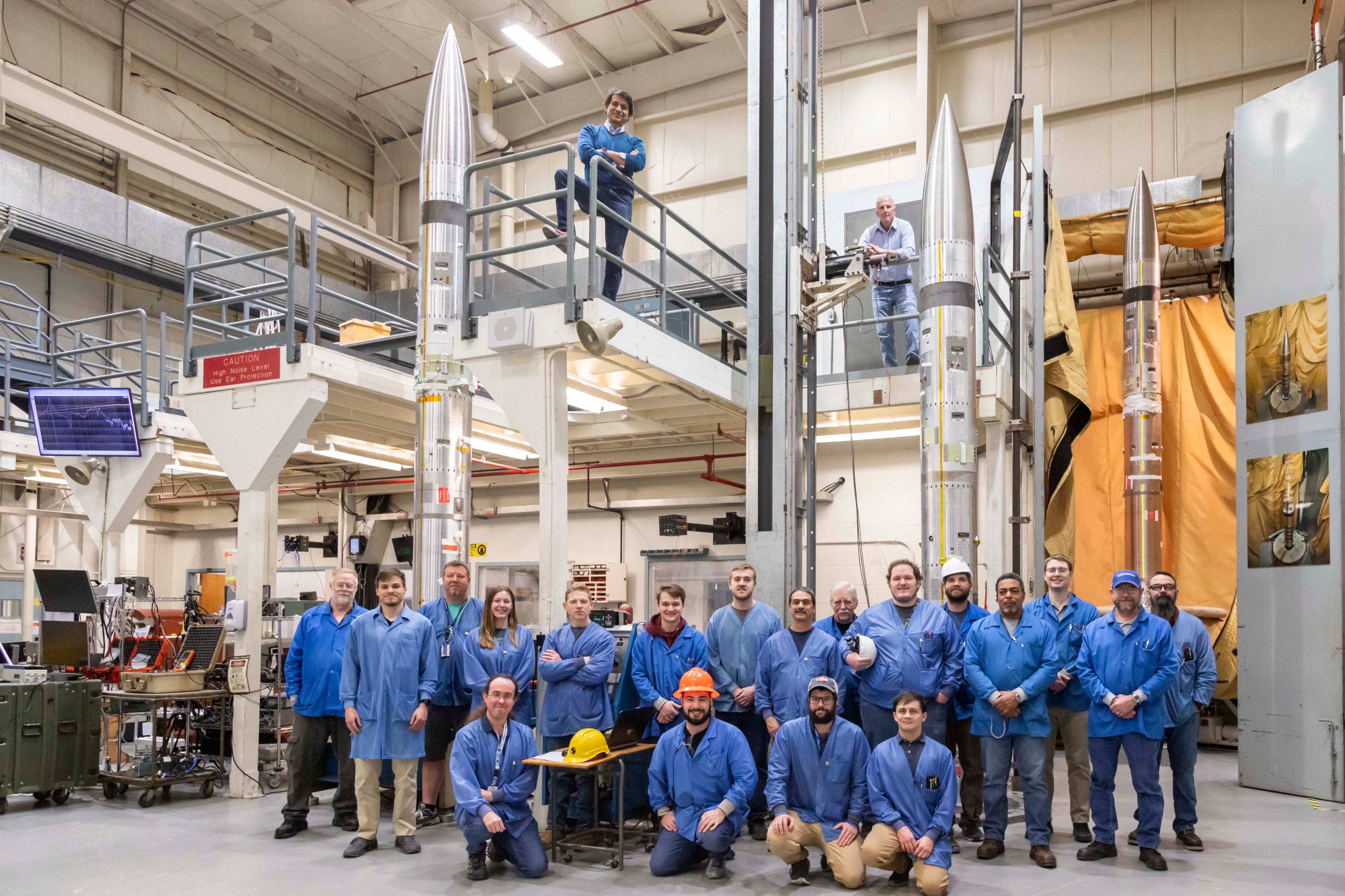
The sounding rockets will launch at three different times: 45 minutes before, during, and 45 minutes after the peak local eclipse. These intervals are important to collect data on how the Sun’s sudden disappearance affects the ionosphere, creating disturbances that have the potential to interfere with our communications.
The ionosphere is a region of Earth’s atmosphere that is between 55 to 310 miles (90 to 500 kilometers) above the ground. “It’s an electrified region that reflects and refracts radio signals, and also impacts satellite communications as the signals pass through,” said Barjatya. “Understanding the ionosphere and developing models to help us predict disturbances is crucial to making sure our increasingly communication-dependent world operates smoothly.”
The ionosphere forms the boundary between Earth's lower atmosphere – where we live and breathe – and the vacuum of space. It is made up of a sea of particles that become ionized, or electrically charged, from the Sun’s energy, or solar radiation. When night falls, the ionosphere thins out as previously ionized particles relax and recombine back into neutral particles. However, Earth’s terrestrial weather and space weather can impact these particles, making it a dynamic region and difficult to know what the ionosphere will be like at a given time.
It’s often difficult to study short-term changes in the ionosphere during an eclipse with satellites because they may not be at the right place or time to cross the eclipse path. Since the exact date and times of the total solar eclipse are known, NASA can launch targeted sounding rockets to study the effects of the eclipse at the right time and at all altitudes of the ionosphere.
As the eclipse shadow races through the atmosphere, it creates a rapid, localized sunset that triggers large-scale atmospheric waves and small-scale disturbances, or perturbations. These perturbations affect different radio communication frequencies. Gathering the data on these perturbations will help scientists validate and improve current models that help predict potential disturbances to our communications, especially high frequency communication.
The APEP rockets are expected to reach a maximum altitude of 260 miles (420 kilometers). Each rocket will measure charged and neutral particle density and surrounding electric and magnetic fields. “Each rocket will eject four secondary instruments the size of a two-liter soda bottle that also measure the same data points, so it's similar to results from fifteen rockets, while only launching three,” explained Barjatya. Three secondary instruments on each rocket were built by Embry-Riddle, and the fourth one was built at Dartmouth College in New Hampshire.
In addition to the rockets, several teams across the U.S. will also be taking measurements of the ionosphere by various means. A team of students from Embry-Riddle will deploy a series of high-altitude balloons. Co-investigators from the Massachusetts Institute of Technology’s Haystack Observatory in Massachusetts, and the Air Force Research Laboratory in New Mexico, will operate a variety of ground-based radars taking measurements. Using this data, a team of scientists from Embry-Riddle and Johns Hopkins University Applied Physics Laboratory are refining existing models. Together, these various investigations will help provide the puzzle pieces needed to see the bigger picture of ionospheric dynamics.
When the APEP sounding rockets launched during the 2023 annular solar eclipse, scientists saw a sharp reduction in the density of charged particles as the annular eclipse shadow passed over the atmosphere. “We saw the perturbations capable of affecting radio communications in the second and third rockets, but not during the first rocket that was before peak local eclipse” said Barjatya. “We are super excited to relaunch them during the total eclipse, to see if the perturbations start at the same altitude and if their magnitude and scale remain the same.”
The next total solar eclipse over the contiguous U.S. is not until 2044, so these experiments are a rare opportunity for scientists to collect crucial data.
The APEP launches will be live streamed via NASA’s Wallops’ official YouTube page and featured in NASA’s official broadcast of the total solar eclipse. The public can also watch the launches in person from 1-4 p.m. at the NASA Wallops Flight Facility Visitor Center .
By Desiree Apodaca NASA’s Goddard Space Flight Center, Greenbelt, Md.
Related Terms
- 2024 Solar Eclipse
- Goddard Space Flight Center
- Heliophysics
- Heliophysics Division
- Heliophysics Research Program
- Science & Research
- Science Mission Directorate
- Skywatching
- Solar Eclipses
- Sounding Rockets Program
- Wallops Flight Facility
Explore More

NASA’s Hubble Pauses Science Due to Gyro Issue

NASA/JAXA’s XRISM Mission Captures Unmatched Data With Just 36 Pixels

NASA’s Webb Maps Weather on Planet 280 Light-Years Away
Discover related topics.
2024 Total Eclipse
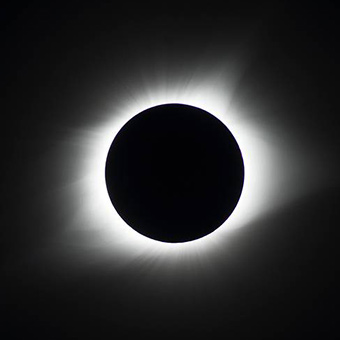
Total Solar Eclipse Safety
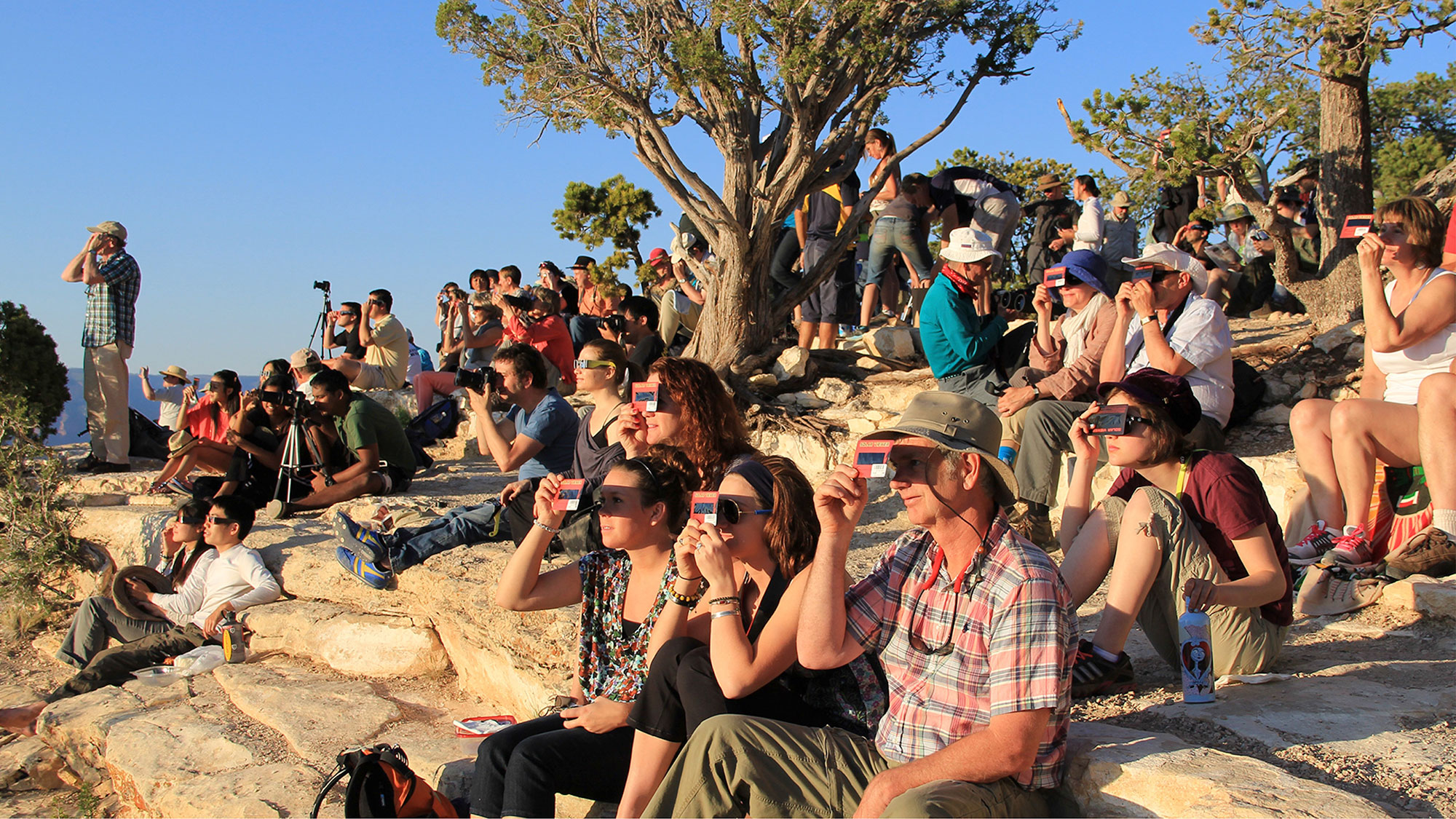
2024 Total Solar Eclipse Broadcast
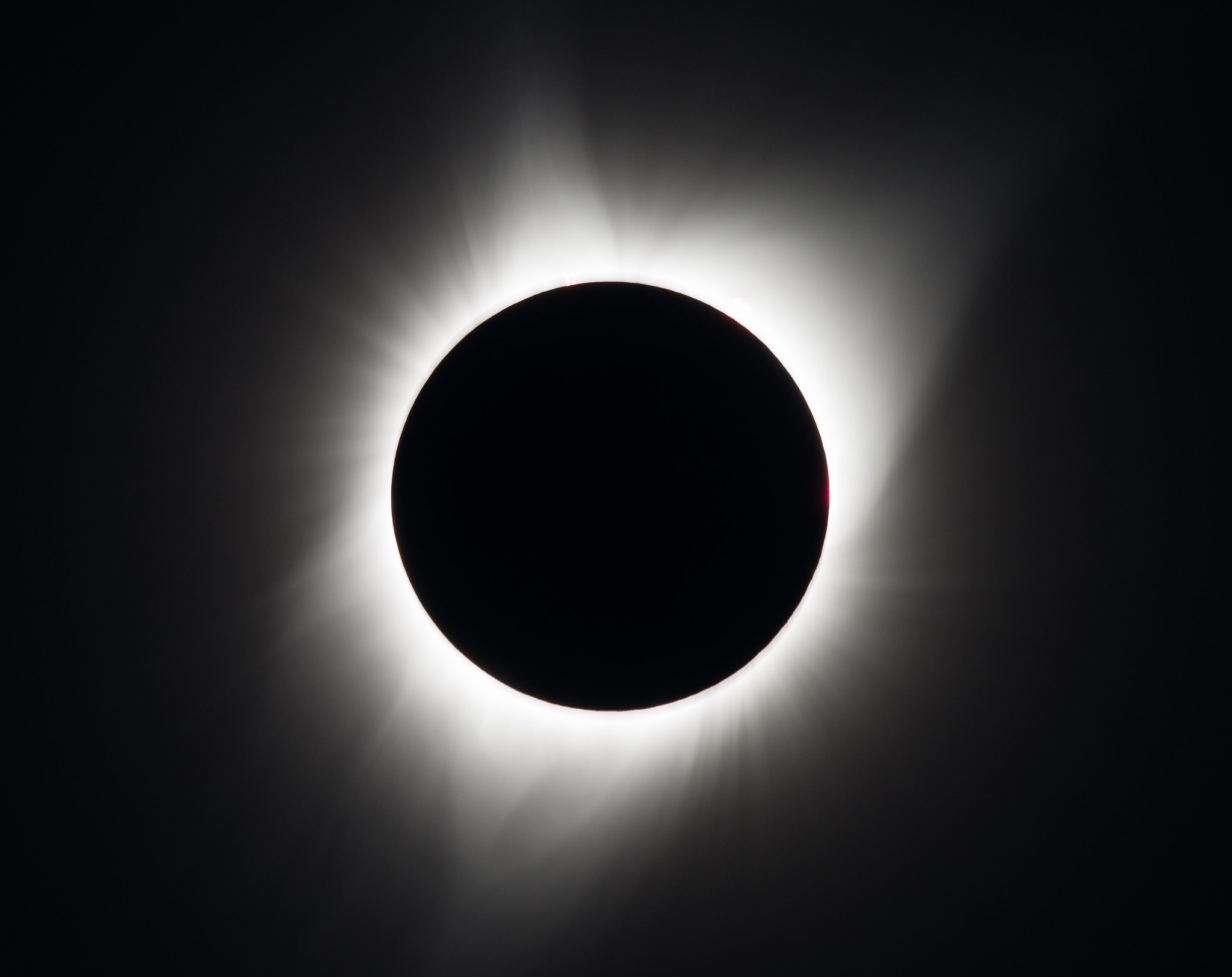
Eclipse 2024 Science
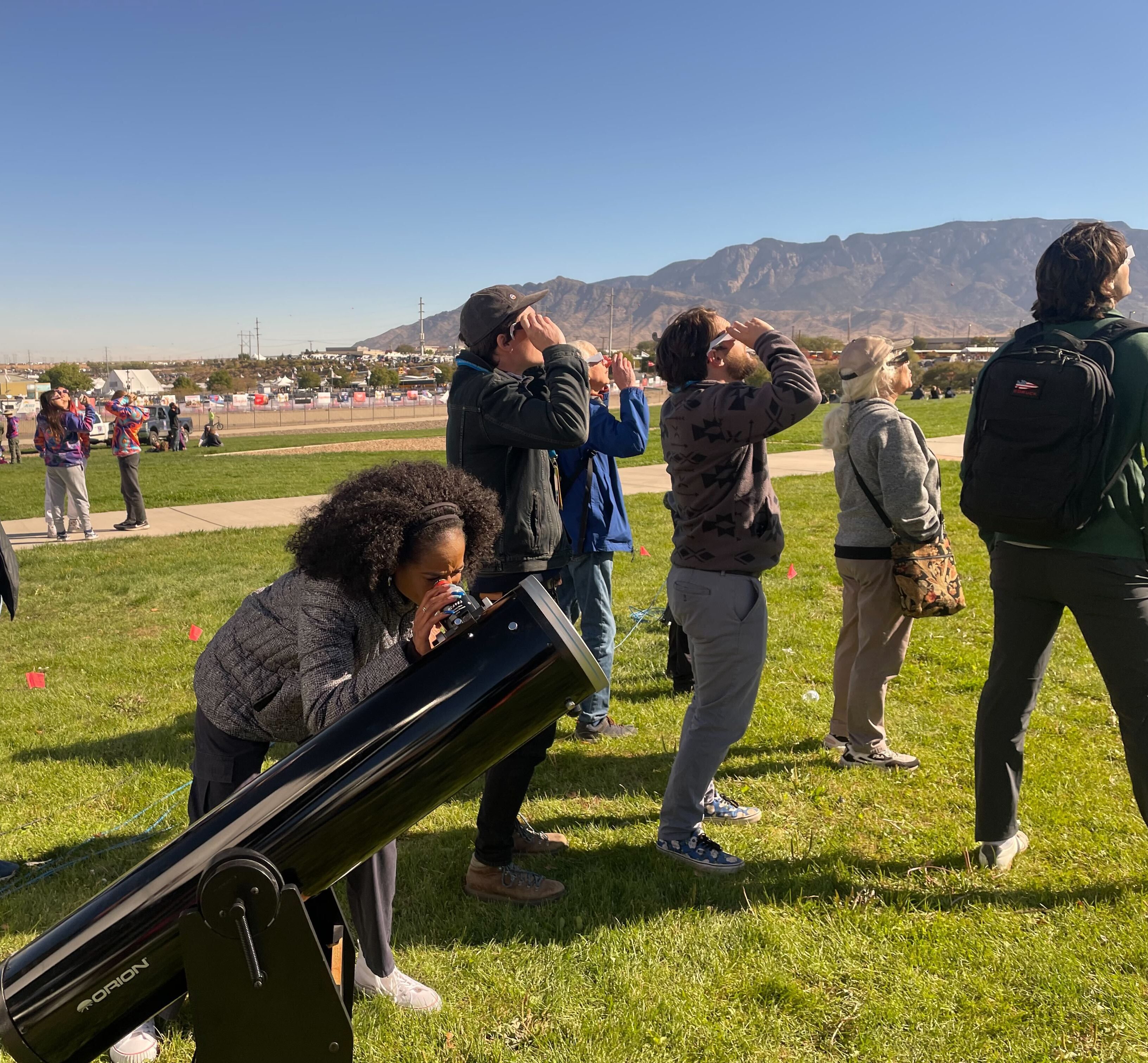
SpaceX late-night rocket launch: Where to watch from Daytona, New Smyrna Beach, Oak Hill
In volusia county, north of kennedy space center & cape canaveral, best views to watch a nighttime rocket launch is along the beach..
Daytona Beach is known for a lot of things: The Daytona 500, beautiful beaches and not to mention Bike Week. But did you know Volusia County is privy to some amazing views of rocket launches from neighboring Brevard County, home to Kennedy Space Center and Cape Canaveral Space Force Station?
You can check it out for yourself.
Day or night, watching a rocket launch on the beach is so Florida.
Weather permitting and depending on cloud cover, yes. We have suggestions on where and how to watch a rocket launch from Ormond Beach to Oak Hill below if you keep scrolling.
Is there a rocket launch in Florida today? Rocket launch calendar for Florida
Here's what we know about the rocket launch missions, mentioned in FLORIDA TODAY's rocket launch calendar for the month, which is updated frequently. (Check that link often for April rocket launch times and dates because they are routinely subject to change for a variety of reasons.)
Is there a rocket launch in Cape Canaveral, Florida? Thursday, May 2: SpaceX Starlink 6-55
A National Geospatial-Intelligence Agency navigational warning indicates SpaceX is targeting Thursday night for its next Starlink mission:
- Mission: A SpaceX Falcon 9 rocket will launch a batch of 23 Starlink internet satellites from Cape Canaveral Space Force Station.
- Launch window: 9:17 p.m. EDT Thursday, May 2, to 1:48 a.m. EDT Friday, May 3
- Location: Launch Complex 40
- Trajectory: Southeast
- Local sonic boom: No
- Booster landing: Drone ship out on the Atlantic Ocean
- Live coverage: Starts 90 minutes before liftoff at floridatoday.com/space .
Where can I watch SpaceX rocket launches online?
If you want to watch live rocket launch coverage, FLORIDA TODAY's Space Team will provide updates at floridatoday.com/space , starting about 90 minutes before launch time. You can download the free app for iPhone or Android or type floridatoday.com/space into your browser.
Can you see a rocket liftoff from Kennedy Space Center in New Smyrna Beach? Where can I see a rocket launch in Volusia County , Florida?
In Volusia County, immediately north of Brevard County — home to Kennedy Space Center and Cape Canaveral Space Force Station — you can get a great view of a SpaceX, NASA or United Launch Alliance rocket launch.
The best views to watch a rocket launch from here is along the beach. Look due south. Readers have also mentioned seeing a rocket launch from New Smyrna Beach, Daytona Beach and Ormond Beach. Here are some recommended spots:
• South New Smyrna Beach (Canaveral National Seashore), there may be parking costs. New Smyrna Beach features 17 miles of white sandy beaches. An eclectic and quaint beach town, despite its reputation as the "Shark Bite Capital of the World," New Smyrna Beach has always been a haven for surfers who come for the waves.
Dinner and a launch: Perfect for a SpaceX or NASA rocket launch, best waterfront restaurants in Volusia County
• Mary McLeod Bethune Beach Park , 6656 S. Atlantic Ave., New Smyrna Beach. Bethune Beach, which is 3.5 miles south of New Smyrna Beach and one mile north of the Apollo Beach entrance to Canaveral National Seashore Park, has restrooms, picnic pavilions, showers and nearly 800 feet of beachfront sidewalk, according to Volusia County's site . The nearby riverside park area is across South Atlantic Avenue with tennis courts, pickle ball courts, basketball and volleyball courts, playground, fishing pier and restrooms. The river by the park can be a great viewing spot for manatees, dolphins and pelicans.
• Apollo Beach at Canaveral National Seashore (south of New Smyrna Beach). Canaveral National Seashore runs along Florida's East Coast in Volusia County and Brevard County. To access Apollo Beach, take Interstate 95 to exit 249, then travel east until it turns into State Road A1A. Follow SR A1A south to the park entrance.
• Oak Hill riverfront is the southernmost city in South Volusia County .
• Sunrise Park , 275 River Road, Oak Hill
• Goodrich's Seafood and Oyster House back deck, 253 River Road, Oak Hill
• Seminole Rest national historic site , 211 River Road, Oak Hill
• Riverbreeze Park , 250 H.H. Burch Road, Oak Hill
• Mary Dewees Park , 178 N. Gaines St., Oak Hill. Facilities include a rental building,playground, baseball field, basketball courts, tennis courts, outdoorrestrooms, pavilions, picnic areas and grills.
• Nancy Cummings Park , 232 Cummings St., Oak Hill. Facilities include a playground, baseball field, basketball courts, outdoor pavilion and restrooms.
• Jimmie Vann Sunrise Park , 275 River Road, Oak Hill. This location has about 350 feet of beautifully restored shoreline, according to the city of Oak Hill online. Facilities include a pavilion, picnic tables and kayak launching facilities.
• A.C. Delbert Dewees Municipal Pier , 243 River Road, Oak Hill. Facilities include a520-foot observation pier with two covered decks and seating, the city of Oak Hill site states.
• Bird Observation Pier on River Road across from A.C. Delbert Municipal Pier (see above). Facilities include a 100-foot observation pier.
Rick Neale is a Space Reporter at FLORIDA TODAY (for more of his stories, click here .) Contact Neale at 321-242-3638 or [email protected] . Twitter/X: @RickNeale1
Blue Origin space tourist launches: Live mission updates
Blue origin's next space tourist mission hasn't yet been announced yet. here are live updates of what we know..
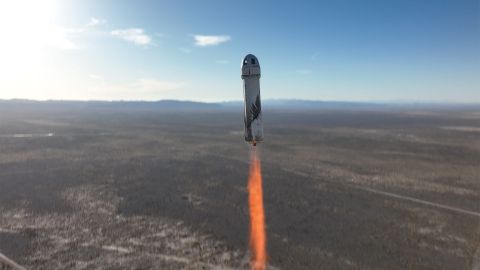
Blue Origin announced its next space tourist mission crew on the New Shepard rocket. The mission, called NS-22, will carry six passengers on a suborbital spaceflight from West Texas.
The launch date is yet to be announced and it will launch from Blue Origin's Launch Site One near Van Horn, Texas. This mission will be Blue Origin's sixth crewed flight and fourth to carry a full six-person crew.
Riding aboard will be: engineer and researcher Sara Sabry, entrepreneur Mário Ferreira, explorer and retired financial manager Vanessa O'Brien, retired U.S. military manager Clint Kelly III, former telecommunications contractor Steve Young, and Dude Perfect co-founder and comedian Coby Cotton. See the latest updates of Blue Origin's NS-22 launch here.
Blue Origin | New Shepard
Blue Origin may wrap up failed launch investigation this month, targets 2023 for crewed launches resuming
Blue Origin may complete its investigation of a September uncrewed launch failure this month, and expects to launch people in 2023, the company said recently.
Audrey Powers, the company's vice-president of the New Shepard rocket mission and flight operations, gave the news at a November conference in Washington, D.C. and Blue Origin officials confirmed the information with Bloomberg in an emailed statement.
In 2021, the company faced highly negative allegations about its culture and the safety of its suborbital launch system, New Shepard . It has launched six crews to date and the launch failure in September is the only major one to date on the system since its first 2015 flight, demonstrating how spaceflight is still hard .
Blue Origin will return husband-wife pair to suborbital space

Sharon Hagle, founder of the non-profit SpaceKids Global, will fly to suborbital space alongside husband Marc (president and CEO of the property development corporation Tricor International) during a future Blue Origin flight.
The timing for the New Shepard spacecraft flight has not been disclosed yet, amid an anomaly investigation during an uncrewed flight last month.
Read more: Blue Origin will return husband-and-wife passengers to suborbital space
Congress asks for Blue Origin investigation transparency

The ongoing investigation of Blue Origin by the Federal Aviation Administration (FAA) is under more government scrutiny.
Congressional leaders of the House Science Subcommittee on Space and Aeronautics recently issued a letter asking the FAA to keep them informed. The failure took place on an uncrewed launch, but another variant of New Shepard launches passengers to suborbital space.
Full story: Congress wants transparency on Blue Origin launch failure investigation by FAA
New Shepard vehicle grounded after launch abort
The next crewed spaceflight for Blue Origin will have to wait. The company's New Shepard booster and capsule are grounded as the Federal Aviation Administration (FAA) conducts a standard accident investigation into an in-flight abort that happened on Monday (Sept. 16).
The mishap caused no injuries and no damage to public property, according to the FAA, which licenses commercial space launches, but the administration grounded the system as per normal procedure.
Full story: Blue Origin's New Shepard rocket grounded as FAA investigates launch failure
Blue Origin space tourists celebrate successful mission

While one of the Blue Origin NS-22 passengers joked his group was "not going to die" on the way down from space Thursday (Aug. 4), the six space tourists told reporters the 11-minute flight was the experience of a lifetime.
"It was more than anything I can put words to. To be honest, I did not expect it to be so emotional," said mechanical and biomedical engineer Sara Sabry, the first person from Egypt to reach space. Sabry is also the founder of Deep Space Initiative (DSI), a nonprofit aiming to increase accessibility for space research.
The mission is Blue Origin's sixth crewed spaceflight.
Read more: 'Woohoo! We're not going to die!' Blue Origin space tourists celebrate successful mission
NS-22 passengers exit the New Shepard spacecraft
The six passengers of NS-22 are exiting their Blue Origin New Shepard spacecraft, meeting with family, friends and well-wishers in the Texas desert.
To recap: New Shepard lifted off from Blue Origin's West Texas site at 9:57 a.m. EDT (1357 GMT) and was back on Earth about 11 minutes later.
The six people on board were Coby Cotton, one of the founders of the popular YouTube channel Dude Perfect; Mário Ferreira and Sara Sabry, who became the first people from Portugal and Egypt, respectively, to reach space; technology pioneer Clint Kelly III; telecommunications executive (not former NFL quarterback) Steve Young; and Vanessa O'Brien.
Read more: Blue Origin launches 6 people on company's 6th space tourism mission
Touchdown of NS-22
Touchdown of NS-22 was just achieved in the Texas desert.
NS-22 descending under parachute
The NS-22 crew is now descending under their parachute, back to Earth.
NS-22 booster makes a landing
The Blue Origin booster that hefted the NS-22 spacecraft into space has made a landing near the launch site in Texas.
Crew now floating free during NS-22 missions
"Sounds like they're having fun upstairs," the Blue Origin broadcast said as the passengers of NS-22 floated free during their brief weightless period. Audio of their exclamations came down from suborbital space, with one of the passengers shouting, "We're doing it!"
Main engine cutoff of NS-22
The NS-22 mission has now achieved main engine cutoff, with New Shepard getting ready to enter suborbital space for a brief "weightless" period for its passengers.
Liftoff on NS-22
Blue Origin's NS-22 lifted off at 9:57 a.m. EDT (1357 GMT) on the company's sixth suborbital crewed spaceflight.
NS-22 go for launch
After a poll in Blue Origin's Mission Control, NS-22 is go for launch.
New Shepard exits hold
The NS-22 mission has exited its hold with an approximate launch time now of 9:57 a.m. EDT (1357 GMT).
New Shepard launch enters hold
The NS-22 launch is in a hold; Blue Origin officials have not yet said on the broadcast why, or how long it will last.
NS-22 climbing into New Shepard spacecraft
Following audio issues that affected the broadcast, the NS-22 group is now visible on screen showing the six people climbing into the New Shepard spacecraft.
Blue Origin delays launch to 9:50 EDT
A Twitter update from Blue Origin says the mission has been delayed by about 20 minutes to 9:50 a.m. EDT (1350 GMT).
" #NewShepard is on the pad," the update stated . "The countdown clock is proceeding towards liftoff within today’s launch window. Due to overnight storms at Launch Site One, we are currently targeting T-0 time at 8:50 a.m. CDT / 13:50 UTC."
Watch Blue Origin launch NS-22 to suborbital space
The next crew to launch on Jeff Bezos' Blue Origin is scheduled to fly Thursday (Aug. 4) at 9:30 a.m. EDT (1330 GMT).
The sixth human spaceflight for the company will see a New Shepard suborbital vehicle lift off from Blue Origin's West Texas site. You can watch live here at Space.com, courtesy of Blue Origin , or directly via the company . Coverage will begin 30 minutes before launch.
The mission — known as NS-22 because it's the 22nd overall New Shepard flight — will carry six people, including Coby Cotton, one of the founders of the popular YouTube channel Dude Perfect.
Read more: Watch Blue Origin launch 6 people to suborbital space today
NS-22 crew announced
Blue Origin unveiled the identities of the next six individuals who will fly to suborbital space. The passengers for the NS-22 mission include the first Egyptian and Portuguese astronauts, Blue Origin announced July 22.
A flight date has not yet been announced, but the timing will be revealed soon, the company added in a statement. The six individuals include:
- Sara Sabry, founder of the Deep Space Initiative and the first person from Egypt to fly to space;
- Mário Ferreira, president of Pluris Investments group and the first person from Portugal to fly into space;
- Vanessa O'Brien, a former financial manager and current British-American explorer seeking to become the first woman to complete the Explorers' extreme trifecta of reaching space;
- Clint Kelly III, former military official including at the Defense Advanced Research Projects Agency (DARPA);
- Steve Young, who ran a telecommunications contracting business in Florida;
- Coby Cotton, who co-founded the YouTube channel Dude Perfect.
More information is available in our Blue Origin NS-22 announcement story .

All six NS-21 astronauts are now out of their ride to space and are celebrating their successful spaceflight with family members and Blue Origin officials.

The New Shepard crew capsule with Evan Dick, Katya Echazarreta, Hamish Harding, Victor Correa Hespanha, Jaison Robinson and Victor Vescovo aboard has safely landed, depending under parachutes and being cushioned by a last-minute blast of air.
Back to Earth
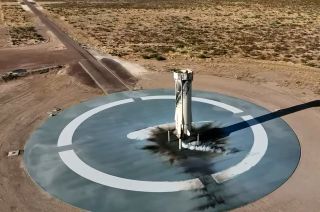
The New Shepard rocket that launch today's NS-21 mission has returned to Earth, firing its engine for a propulsive landing on four legs.
This was the seventh launch and landing for this booster.

Welcome to Space!
Unofficial numbers suggest that Blue Origin's NS-21 passengers reached an apogee of about 351,183 feet (107,040 meters).
Katya Echazarreta, Hamish Harding, Victor Correa Hespanha, Jaison Robinson and Victor Vescovo are now the 623rd to 627th people to fly above the U.S.-recognized boundary of 50 miles (80 km) to become astronauts. (Evan Dick, having flown before, was number 609.)
'RSS First Step' Away!
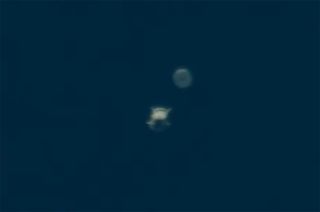
The New Shepard booster and crew capsule have separated.
Soon, the booster will begin its descent back to Earth as the capsule, "RSS First Step," coasts the rest of the way to space.
3…2…1… Lift-off!

New Shepard has launched at 9:25 a.m. EDT (1325 GMT).
Message From A Moonwalker
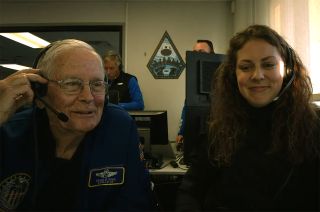
Apollo 16 moonwalker Charlie Duke is in Blue Origin's Mission Control for today's launch and had a special message for the NS-21 crew.
"Congratulations on this flight that you're about to embark on," said Duke. "I know you're going to have an exciting adventure, just as I did 50 years ago."
"Have a great ride and I look forward to seeing you when you get back. Godspeed," he said.
Passengers Strap Into New Shepard for Launch
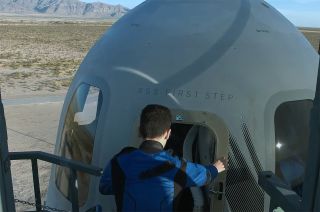
After receiving a brief safety review, the six NS-21 space tourists have crossed the gantry and boarded "RSS First Step," Blue Origin's crew-configured capsule. Each crew member has their own window seat — the largest windows ever launched into space.
NS-21 Space Tourists Depart for Launch Pad

The space tourists flying on today's NS-21 mission are suited up and have left for their launchpad.
The six are riding to their rocket in electric Riven trucks. Once at Launch Site One, they will climb seven flights of stairs and cross a gantry to board New Shepard.
T-minus 40 minutes and counting...
Launch Day for Blue Origin’s NS-21 Space Tourists

The countdown is on for Blue Origin's fifth crewed flight for its New Shepard suborbital launch vehicle and the 21st in its history. Six passengers — including Blue Origin's first repeat customer — are set to lift off at 9:00 a.m. EDT (1300 GMT) and you can watch it live on Space.com beginning at 8:00 a.m. EDT (1200 GMT).
Today's launch will include the first Mexican-born woman and youngest American woman to become a space tourist and the second Brazilian to fly into space. It also marks the start of Space for Humanity's civilian astronaut program, with the non-profit sending its first sponsored leader on a mission to implement the overview effect here on Earth.
The NS-21 mission's passengers include:
- Evan Dick , the first person to fly on New Shepard twice, having previously launched on NS-19 in December 2021.
- Katya Echazarreta , the first to fly as part of Space for Humanity's sponsored Citizen Astronaut Program, which is led by Dylan Taylor, who flew on NS-19 with Dick.
- Hamish Harding , who previously broke the Round-the-World record for any aircraft flying over the North and South poles, flying alongside former NASA astronaut Terry Virts.
- Victor Correa Hespanha , self-described as the world's first cryptonaut, his seat is sponsored by the Crypto Space Agency.
- Jaison Robinson , a contestant on the television reality show "Survivor" in 2009.
- Victor Vescovo , the first person to repeatedly dive to the deepest point in the ocean, Challenger Deep (now twelve times), including dives with former astronauts Kathy Sullivan and Richard Garriott, as well as his NS-21 crewmate Hamish Harding.
All six passengers either paid for or were sponsored to fly on New Shepard. Blue Origin has not disclosed what each have paid for a flight, or what a single seat costs.
Leading up to today, the NS-21 crew spent two days at Blue Origin’s West Texas launch site training for the launch.
Blue Origin clears New Shepard for NS-21 crew launch
Blue Origin has officially given the "go" for its New Shepard rocket to launch six passengers on the suborbital NS-21 mission on Saturday, June 4, 2022. Liftoff is targeted for 9 a.m. EDT (1300 GMT).
Blue Origin will livestream the launch on YouTube beginning at 8 a.m. EDT (1200 GMT). Here's a look at Blue Origin's countdown schedule for the mission.
#NS21 is officially “go” for launch tomorrow. Learn more: https://t.co/1ztUVUURgn. Live webcast of begins at T-60 minutes on https://t.co/7Y4TherpLr. Here’s what to expect on launch day. 🚀 pic.twitter.com/PWHOxAl09v June 3, 2022
Blue Origin's next space tourist flight

Blue Origin is counting down to the launch of its NS-21 space tourist mission on June 4 from the company's West Texas-based Launch Site One near Van Horn. Liftoff is set for 9 a.m. EDT (1300 GMT) , with a webcast beginning one hour before launch time at 8 a.m. EDT (1200 GMT) .
The mission has been delayed since May 20, when technical issues and the need for more booster checks on its New Shepard rocket prompted the company to stand down from the mission.
NS-21 will launch six passengers on a short suborbital spaceflight, with the New Shepard booster returning to Earth for a vertical landing and the crew capsule parachuting to the surface shortly afterward.
The crew of Blue Origin's NS-21 mission includes:
Evan Dick will be the first person to fly aboard a New Shepard spacecraft twice, having been a participant in the NS-19 mission of Dec. 11, 2021. He is a pilot, engineer, investor and managing member of Dick Holdings, LLC. Previously, he was senior vice president of D.E. Shaw and managing director of Highbridge Capital Management. He supports the Darwin Foundation, Population Relief International Corp. and Starfighters Aerospace either through charity or as a volunteer, according to Blue Origin's NS-21 mission announcement .
Katya Echazarreta
Katya Echazarreta, born in Guadalajara, will become the first Mexican-born individual to visit space. She is the co-host of the YouTube series "Netflix IRL" and "Electric Kat" on the CBS show "Mission Unstoppable." She spent nearly four years at NSAA's Jet Propulsion Laboratory in Southern California, working on space missions including the Perseverance Mars rover and Europa Clipper, which will launch toward the Jupiter moon Europa in 2024. She is pursuing a masters degree in electrical and computer engineering at Johns Hopkins University and aims to "provide representation for women and minorities" for those interested in science, technology, engineering and mathematics (STEM), according to Blue Origin. Her seat was sponsored by the nonprofit Space for Humanity .
Hamish Harding
Hamish Harding is chair of the business jet brokerage company Action Aviation, as well as a business jet pilot. He holds several aviation world records, including a 2019 milestone with retired NASA astronaut Terry Virts for breaking a round-the-world record for aircraft flying over the north and south poles. Harding has also visited the South Pole twice and dove to 36,000 feet (nearly 10,100 meters) in a submarine in 2021.
Victor Correa Hespanha
Victor Correa Hespanha, 28, is a civil production engineer from the Brazilian state of Minas Gerais. His seat was sponsored by the Crypto Space Agency, and he is identifying himself as the world's first cryptonaut. He is also the second Brazilian to fly in space, according to Blue Origin.
Jaison Robinson
Jaison Robinson founded the commercial real estate company JJM Investments and co-founded Dream Variations Ventures with his wife, Jamie. Robinson lists himself as an avid scuba diver and skydiver with a variety of adventurous activities under his belt, such as breaking the sound barrier in a Mig-29 jet, making Eagle Scout, playing water polo at Stanford University and becoming a finalist in "Survivor: Samoa" in 2009.
Victor Vescovo
Victor Vescovo is a co-founder of the private equity investment firm Insight Equity. He completed an "Explorer's Grand Slam," which is an adventurer community term for skiing to the North and South Poles and climbing the highest mountains on the world's seven continents, including Everest. He is a commercially rated multi-engine jet and helicopter pilot, as well as a certified submersible test pilot, and he has visited the Challenger Deep (the deepest point in the ocean) 12 times, according to Blue Origin. He also served 20 years in the U.S. Navy Reserve as an intelligence officer, retiring as a commander.
Below you can scroll down to see Blue Origin's last space tourist flight NS-20 in March 2022.
Hear from Blue Origin passengers
Passengers on today's Blue Origin suborbital launch shared their comments about the flight after exiting the capsule. "That is an eternal black," Jim Kitchen said of his view of space. "It's just breathtaking."
"The most beautiful thing I've ever seen"
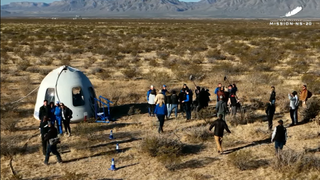
All six passengers have exited the New Shepard capsule and reunited with friends and family who were on hand to greet them. They will now receive astronaut wings from Blue Origin's Audrey Powers, who herself flew on a mission in October.
Stepping out
Blue Origin personnel are on scene at the landing site and are preparing to assist the six crewmembers out of the New Shepard capsule.
Safe landing

Blue Origin personnel have spoken with all six crewmembers inside the landed capsule and are approaching the touchdown site to retrieve the passengers.
Both booster and capsule have touched down in the West Texas desert at the end of about 10 minutes of flight for six passengers.
Unofficial numbers suggest that Blue Origin's NS-20 mission reached an apogee of about 351,000 feet (107,000 meters).
Stage separation
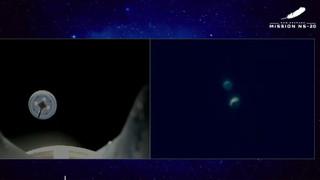
New Shepard's booster and capsule seen shortly after separation on March 31, 2022.
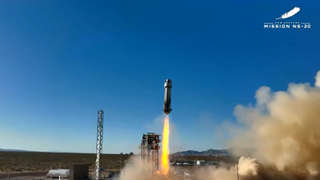
Final minutes to launch
Launch of Blue Origin's NS-20 crewed mission is less than 3 minutes away, with final checks underway.
Countdown resumes!
Blue Origin has resumed counting down to launch today; launch will now occur just a few minutes before 10 a.m. EDT (1400 GMT).
New Shepard remains in a hold
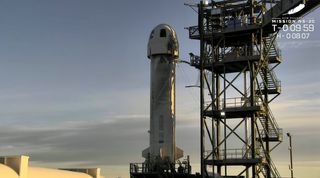
Blue Origin's New Shepard vehicle remains in a hold at T-9:59 as the delay nears half an hour. The company has not offered any details about the cause of the hold. Astronauts remain strapped into their seats in the capsule.
Gantry pulls away from New Shepard rocket

The gantry of Blue Origin's Launch Site One has pulled away from the New Shepard rocket as the NS-20 crew awaits launch.
Blue Origin is still at T-9 minutes, 59 seconds and holding as flight controllers check the rocket's systems and weather conditions for today's launch.
Blue Origin holds countdown for NS-20 launch
Blue Origin has stopped its launch countdown at T-10 minutes from launch.
The company has not stated the reason for the hold yet.
The NS-20 passengers are buckled in for launch and just received a message from Blue Origin's NS-19 crew, the first six-person crew. One message from Michael Strahan was particularly cheering: "This is the best ride ever have, but it's way too short," he wrote.
Blue Origin passenger carrying Ukrainian flag to space
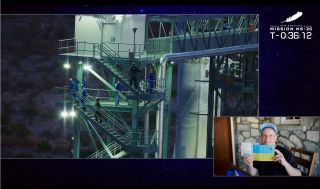
Blue Origin NS-20 passenger Jim Kitchen will take a small Ukrainian flag to space on New Shepard's launch, along with the passport he used to visit the country, which will be in the flight suit pocket over his heart for today's launch, Blue Origin reports.
The NS-20 crew has arrived at their New Shepard capsule and are now ingressing the spacecraft. Earlier, they crossed a gantry and rang a ceremonial ships bell before reaching the capsule.
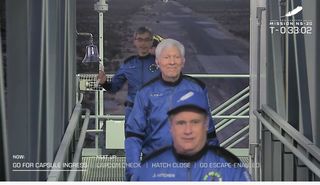
Blue Origin NS-20 crew arrives at launch pad
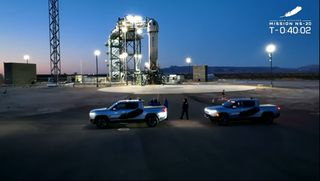
Blue Origin's NS-20 crew has arrived at Launch Site One to prepare to board their New Shepard spacecraft. As they arrived, dawn broke over their West Texas launch site.
The private astronauts are now climbing the seven-story gantry to reach the boarding level for New Shepard.
Blue Origin gives go for NS-20 crew departure.
Blue Origin has cleared its NS-20 space tourist passengers to head to the launch pad and board their New Shepard spacecraft.
The passengers will head over in electric Riven trucks. Once at the Launch Site One pad, they'll climb seven flights of stairs and cross a gantry to board New Shepard.
It's currently dark at Blue Origin's launch site as the sun has yet to rise.
Blue Origin NS-20 launch webcast live
Blue Origin's launch webcast for the NS-20 mission is live about 20 minutes ahead of schedule. Blue Origin appears to now be targeting 9:10 a.m. EDT (1310 GMT) for its launch today.
Blue Origin reports it is running ahead of its timeline for today's planned launch. Here's a look at the launch timeline from Blue Origin.
We’re running ahead of schedule; live webcast will begin at 7:10 am CDT / 12:10 UTC on https://t.co/7Y4TherpLr. Here are the key moments during today’s countdown to launch to look for on the webcast: March 31, 2022
#NewShepard is on the pad for its 20th mission. Flight controllers are working through nominal check-outs in advance of today’s launch. Before liftoff, meet the #NS20 crew as they prepare for their journey to space. pic.twitter.com/O999O1Zdw1 March 31, 2022
It's launch day for Blue Origin's NS-20 space tourists
Blue Origin is counting down to launch its next space tourist mission, NS-20, from its Launch Site One in West Texas today. The mission will launch at 9:30 a.m. EDT (1330 GMT) and you'll be able to watch it live on Space.com beginning at 8:30 a.m. EDT (1230 GMT) .
Today's mission will mark Blue Origin's first crewed flight of 2022 and the company's fourth crewed flight overall since it began launching passengers to space in July 2021. That first Blue Origin carried the company's founder Jeff Bezos, among others. Bezos will likely be on hand for today's launch as he has driven past crews to the launch pad himself.
This mission will carry six passengers. They include:
- Gary Lai , the chief architect of the New Shepard system, a reusable rocket-capsule combo. He joined Blue Origin in 2004 and was one of its first 20 employees;
- Sharon Hagle , the founder of SpaceKids Global, a nonprofit that was established in 2015 to encourage students, especially girls, to push forward their STEAM (science, technology, education, art and math) education and pursue careers in space. SpaceKids is also a participant in "Postcards to Space," a program run by Blue Origin's nonprofit organization Club for the Future.
- Marc Hagle , husband of Sharon, is president and CEO of the property development corporation Tricor International.
- Marty Allen , a past CEO and a current angel investor and mentor. He was the former CEO of the California Closet Company, which provides custom home storage ideas, along with Party America, which is now a nationwide retailer.
- Jim Kitchen , a faculty member of the University of North Carolina’s Kenan-Flagler Business School, and an entrepreneur.
- George Nield , president of Commercial Space Technologies, LLC, which seeks to broaden commercial space activities, and the former associate administrator for the Federal Aviation Administration's Office of Commercial Space Transportation.
Gary Lai and George Nield are flying on this mission as guests of Blue Origin, while the other crewmembers are paying passengers. Blue Origin has not disclosed what each of the paying passengers have paid for a flight on New Shepard, or what a single seat costs.
The NS-20 crew has spent the last two days training for today's flight. Here are some photos from the training.
- 2 Everything we know about James Gunn's Superman
- 3 Sneak peek: Browncoats grab victory in Boom! Studios' upcoming 'Firefly: 'Verses' comic (exclusive)
- 4 SpaceX launches 23 Starlink satellites from Florida
- 5 NASA's mission to an ice-covered moon will contain a message between water worlds
Falcon 9 Block 5 | WorldView Legion 1 & 2
Falcon 9 block 5 | starlink group 6-55, long march 5 | chang'e 6.

Latest News

ISS Roundup: an eclipse, an EVA, and more than just science returns to Earth

Launch Roundup: China returns to the moon, SpaceX keeps up high launch cadence

NASA Updates on Starship Refueling, as SpaceX Prepares Flight 4 of Starship

Here’s What Else Happens Eclipse Day: ‘Devil Comet,’ Rocket Launches And Dark Matter
T he United States’ first total solar eclipse in seven years will occur Monday, but other space-related events will also take place that day, including rocket launches, the potential to witness the “devil comet” and a dark matter experiment.
As a part of the Atmospheric Perturbations around Eclipse Path mission, NASA is launching three rockets into the moon’s shadow on Monday during the total solar eclipse to better understand what happens to Earth’s upper atmosphere when the sun is temporarily dimmed.
This event will be livestreamed along with NASA’s livestream feed of the total solar eclipse, and the launch window time for the rockets is between 2:40 p.m. EDT and 4:05 p.m. EDT.
Comet 12P/Pons-Brooks, dubbed the “devil comet” for its horns, may be visible during the total solar eclipse to those within the path of totality, according to NASA.
Comets aren’t typically visible to the naked eye during the day, but the devil comet may become visible in the sky close to Jupiter momentarily during the eclipse because the sky will darken once the moon blocks the sun.
The European Council for Nuclear Research (CERN) will fire up the Large Hadron Collider , the most powerful particle accelerator in the world, on Monday and collide protons together to simulate the Big Bang.
Though this won’t be happening in space, the goal of the experiment is to search for dark matter , because although scientists have been able to theorize it exists due to the gravitational effects it has on visible matter, no one’s actually ever seen it before.
What To Watch For
Some astronomers predict a phenomenon called the double diamond ring may occur during the solar eclipse. This is a rare event that happens when the last glimpse of the sun as it’s dimming suddenly turns into a bright flash around its rim, before appearing to extinguish completely. The first ring happens when the moon first eclipses the sun—called totality—and the second occurs at the end of totality. However, only those near the center of totality will be able to witness this phenomenon, though others within the path may see at least one ring.
Between 931,000 and 3.7 million. That’s how many people are expected to travel to parts of the U.S. within the solar eclipse’s path of totality Monday, according to eclipse tracking organization Great American Eclipse. This adds on to the 31 million people already living in eclipse states that GAE expects to participate.
Key Background
A total solar eclipse happens when the moon passes between Earth and the sun and completely blocks the face of the sun, causing the sky to darken. Monday will be the first time since 2017 the U.S. will witness a total solar eclipse, when it previously passed through 14 states including Georgia and Tennessee. The path of totality this year will only pass through Texas, Oklahoma, Arkansas, Missouri, Illinois, Kentucky, Indiana, Ohio, Pennsylvania, New York, Vermont, New Hampshire, and Maine, though small regions in Michigan and Tennessee will be in the path as well, according to NASA. Certain regions in Mexico and Canada will also be within the path. However, all 48 contiguous states will be able to see a partial eclipse. In preparation for the influx of visitors and traffic, some states, counties and cities have declared states of emergencies.
Further Reading
Everything To Know About The Total Solar Eclipse—Including Map And Path Tracker (Forbes)
Here’s Why The Total Solar Eclipse Has Prompted States Of Emergency In Parts Of U.S. (Forbes)
Here’s How The Niagara Falls Region Is Readying For An Influx Of Eclipse Tourists (Forbes)

- production services
- FILM PERMITS
- EQUIPMENT RENTAL
- LOCATION SCOUTING
- TRANSPORT SERVICES
- RISK ASSESMENT
- STUDIO RENTAL
- DRONE FILMING
- LEGAL CONSULT
- INTERNATIONAL COORDINATION
- COMMERCIALS
- documentaries
- broadcast & stream
- corporate videos
- SAINT PETERSBURG
- IRKUTSK AND LAKE BAIKAL
- VLADIVOSTOK
- EKATERINBURG
- Arkhangelsk
- PERESLAVL ZALESSKY
- VLADIMIR AND SUZDAL
- SERGEEV POSAD
- about russia
- general information
- local laws and regulations
- drone and aerial filming
- Our projects
Our fixers working on Dark Tourist, Netflix
Our fixers in Russia and Kazakhstan help build up a complex filming of the launch of a Soyuz rocket.
Dark Tourist is a very interesting Netflix documentary series. It tells about the phenomenon of “dark tourism”. The locations and stories shown in this show are gorgeous. We are proud to say that our fixers were in charge of the episode filmed in Baikonur, Kazakhstan. FilmspbTV organized the visit of the host of the show to the launch of a Soyuz rocket to the ISS, as well as the filming of the lift off and erection of the rocket. Luckily our film crew got to the press conference given by the astronauts.
In episode 4 David Farrier travels through Kazakhstan to get to the place where most Russian rockets are launched to space – the cosmodrome Baikonur. FilmspbTV crew was in charge of the permit-getting procedure, logistics, accommodation and production support during the launch and the preparation.
Below you will find the trailer of the show. Watch the complete show on Netflix.
If you are interested in filming a rocket launch from Baikonur or filming with zero gravity in a special plane – please contact us
Services: Scouting, filming permits, logistics
Local Crew: Fixer
Location: Baikonur, Kazakhstan

YOU MAY ALSO LIKE...

Documentary project “Unsere Continente” for Terra-X, ZDF

Top Gear filming in Russia. FilmspbTV. Season 22 episode 1
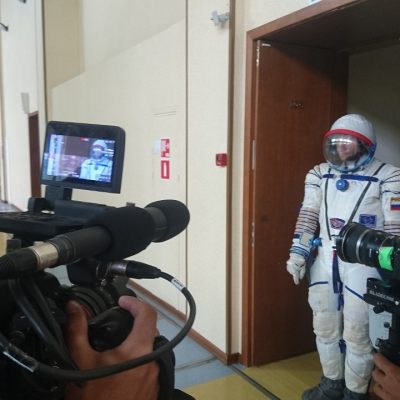
Ultimo tren a Russia – award winning ESPN series

TvN and Netflix. Bulgasal: Immortal souls. Filming in Siberia
[email protected]
CONTACT US ON TELEGRAM or whatsapp
+7 904 601-22-32

Suggested Searches
- Climate Change
- Expedition 64
- Mars perseverance
- SpaceX Crew-2
- International Space Station
- View All Topics A-Z
- Humans in Space
Earth & Climate
The solar system, the universe, aeronautics, learning resources, news & events.

NASA/JAXA’s XRISM Mission Captures Unmatched Data With Just 36 Pixels

NASA Scientists Gear Up for Solar Storms at Mars

NASA Uses Small Engine to Enhance Sustainable Jet Research
- Search All NASA Missions
- A to Z List of Missions
- Upcoming Launches and Landings
- Spaceships and Rockets
- Communicating with Missions
- James Webb Space Telescope
- Hubble Space Telescope
- Why Go to Space
- Astronauts Home
- Commercial Space
- Destinations
- Living in Space
- Explore Earth Science
- Earth, Our Planet
- Earth Science in Action
- Earth Multimedia
- Earth Science Researchers
- Pluto & Dwarf Planets
- Asteroids, Comets & Meteors
- The Kuiper Belt
- The Oort Cloud
- Skywatching
- The Search for Life in the Universe
- Black Holes
- The Big Bang
- Dark Energy & Dark Matter
- Earth Science
- Planetary Science
- Astrophysics & Space Science
- The Sun & Heliophysics
- Biological & Physical Sciences
- Lunar Science
- Citizen Science
- Astromaterials
- Aeronautics Research
- Human Space Travel Research
- Science in the Air
- NASA Aircraft
- Flight Innovation
- Supersonic Flight
- Air Traffic Solutions
- Green Aviation Tech
- Drones & You
- Technology Transfer & Spinoffs
- Space Travel Technology
- Technology Living in Space
- Manufacturing and Materials
- Science Instruments
- For Kids and Students
- For Educators
- For Colleges and Universities
- For Professionals
- Science for Everyone
- Requests for Exhibits, Artifacts, or Speakers
- STEM Engagement at NASA
- NASA's Impacts
- Centers and Facilities
- Directorates
- Organizations
- People of NASA
- Internships
- Our History
- Doing Business with NASA
- Get Involved
- Aeronáutica
- Ciencias Terrestres
- Sistema Solar
- All NASA News
- Video Series on NASA+
- Newsletters
- Social Media
- Media Resources
- Upcoming Launches & Landings
- Virtual Events
- Sounds and Ringtones
- Interactives
- STEM Multimedia

NASA’s Hubble Pauses Science Due to Gyro Issue

NASA’s Webb Maps Weather on Planet 280 Light-Years Away

NASA’s Commercial Partners Deliver Cargo, Crew for Station Science

NASA Shares Lessons of Human Systems Integration with Industry

Work Underway on Large Cargo Landers for NASA’s Artemis Moon Missions

NASA-Led Study Provides New Global Accounting of Earth’s Rivers

NASA’s ORCA, AirHARP Projects Paved Way for PACE to Reach Space

Amendment 11: Physical Oceanography not solicited in ROSES-2024

Major Martian Milestones

Correction and Clarification of C.26 Rapid Mission Design Studies for Mars Sample Return

Webb Captures Top of Iconic Horsehead Nebula in Unprecedented Detail

NASA Photographer Honored for Thrilling Inverted In-Flight Image

NASA’s Ingenuity Mars Helicopter Team Says Goodbye … for Now

Tech Today: Stay Safe with Battery Testing for Space

NASA Data Helps Beavers Build Back Streams

NASA Grant Brings Students at Underserved Institutions to the Stars

Washington State High Schooler Wins 2024 NASA Student Art Contest

NASA STEM Artemis Moon Trees

NASA’s Commitment to Safety Starts with its Culture

NASA Challenge Gives Space Thruster Commercial Boost

Diez maneras en que los estudiantes pueden prepararse para ser astronautas

Astronauta de la NASA Marcos Berríos

Resultados científicos revolucionarios en la estación espacial de 2023
Nasa sets coverage for boeing starliner’s first crewed launch, docking.
Tiernan P. Doyle
Nasa headquarters.
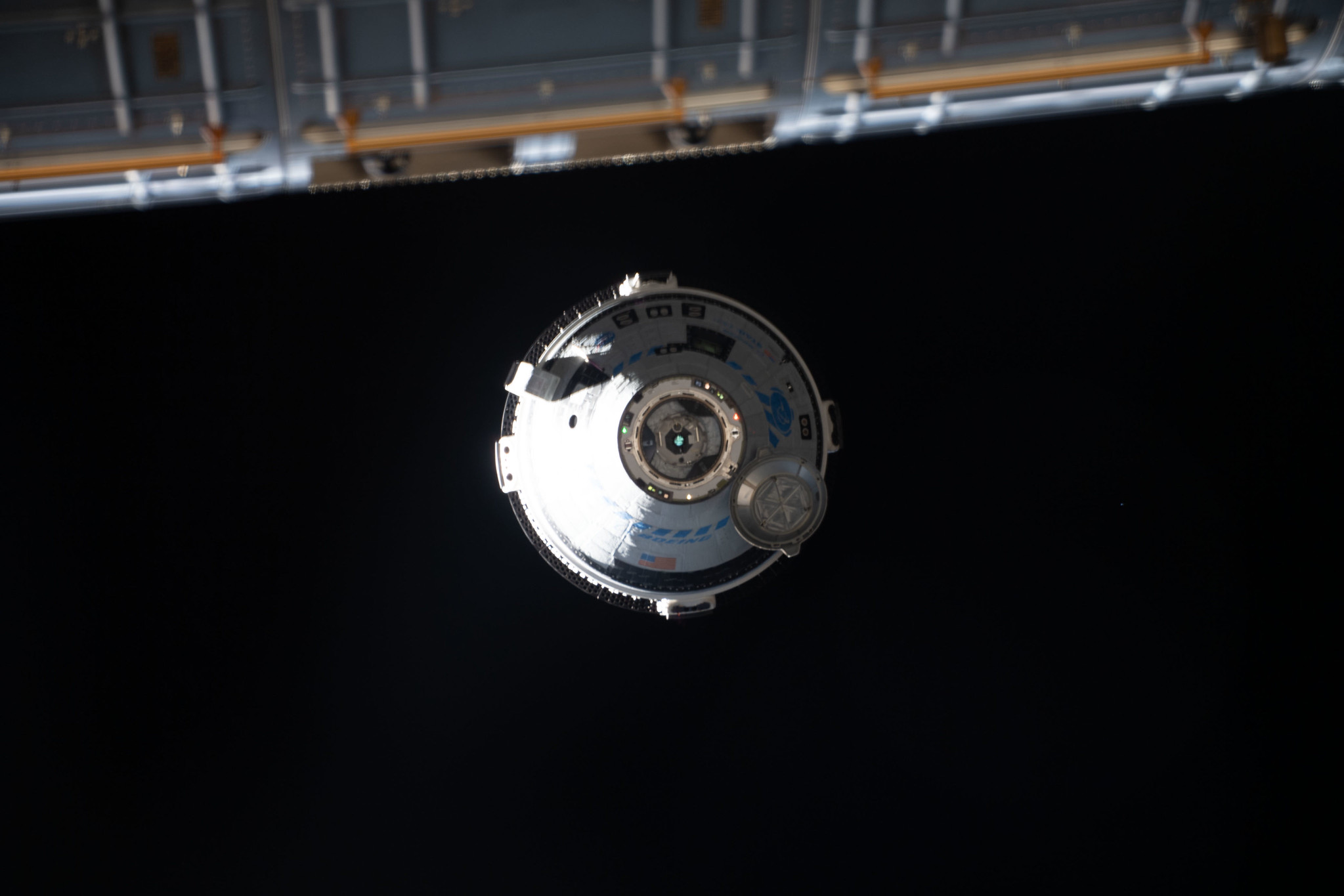
NASA will provide live coverage of prelaunch and launch activities for the agency’s Boeing Crew Flight Test, which will carry NASA astronauts Butch Wilmore and Suni Williams to and from the International Space Station.
Launch of the ULA (United Launch Alliance) Atlas V rocket and Boeing Starliner spacecraft is targeted for 10:34 p.m. EDT Monday, May 6, from Space Launch Complex-41 at Cape Canaveral Space Force Station in Florida.
The flight test will carry Wilmore and Williams to the space station for about a week to test the Starliner spacecraft and its subsystems before NASA certifies the transportation system for rotational missions to the orbiting laboratory for the agency’s Commercial Crew Program.
Starliner will dock to the forward-facing port of the station’s Harmony module at 12:48 a.m., Wednesday, May 8.
The deadline for media accreditation for in-person coverage of this launch has passed. The agency’s media credentialing policy is available online. For questions about media accreditation, please email: [email protected] .
NASA’s mission coverage is as follows (all times Eastern and subject to change based on real-time operations):
Wednesday, May 1
1:30 p.m. – Virtual news conference at Kennedy with the flight test astronauts:
- NASA astronaut Butch Wilmore
- NASA astronaut Suni Williams
Coverage of the virtual news conference will stream live on NASA+ , NASA Television, the NASA app , YouTube , and the agency’s website .
Media may ask questions via phone only. For the dial-in number and passcode, please contact the Kennedy newsroom no later than 12:30 p.m., Wednesday, May 1, at: [email protected] .
Friday, May 3 12:30 p.m. – Prelaunch news conference at Kennedy (no earlier than one hour after completion of the Launch Readiness Review) with the following participants:
- NASA Administrator Bill Nelson
- Steve Stich, manager, NASA’s Commercial Crew Program
- Dana Weigel, manager, NASA’s International Space Station Program
- Emily Nelson, chief flight director, NASA
- Jennifer Buchli, chief scientist, NASA’s International Space Station Program
- Mark Nappi, vice president and program manager, Commercial Crew Program, Boeing
- Gary Wentz, vice president, Government and Commercial Programs, ULA
- Brian Cizek, launch weather officer, 45th Weather Squadron, Cape Canaveral Space Force Station
Coverage of the prelaunch news conference will stream live on NASA+ , NASA Television, the NASA app , YouTube , and the agency’s website .
Media may ask questions in person and via phone. Limited auditorium space will be available for in-person participation. For the dial-in number and passcode, media should contact the Kennedy newsroom no later than 11:30 a.m., Friday, May 3, at [email protected] .
3:30 p.m. – NASA Social panel live stream event at Kennedy with the following participants:
- Ian Kappes, deputy launch vehicle office manager, NASA’s Commercial Crew Program
- Amy Comeau Denker, Starliner associate chief engineer, Boeing
- Caleb Weiss, system engineering and test leader, ULA
Coverage of the panel live stream event will stream live at @NASAKennedy on YouTube, @NASAKennedy on X, and @NASAKennedy on Facebook. Members of the public may ask questions online by posting questions to the YouTube, X, and Facebook livestreams using #AskNASA.
Monday, May 6
6:30 p.m. – Launch coverage begins on NASA+ , NASA Television, the NASA app , YouTube , and the agency’s website .
10:34 p.m. – Launch
Launch coverage on NASA+ will end shortly after Starliner orbital insertion. NASA Television will provide continuous coverage leading up to docking and through hatch opening and welcome remarks.
Tuesday, May 7
12 a.m. – Postlaunch news conference with the following participants:
- NASA Deputy Administrator Pam Melroy
- Ken Bowersox, associate administrator, NASA’s Space Operations Mission Directorate
Coverage of the postlaunch news conference will air live on NASA+ , NASA Television, the NASA app , YouTube , and the agency’s website .
NASA+ will resume coverage and NASA Television’s media channel will break from in-orbit coverage to carry the postlaunch news conference. Mission operational coverage will continue on NASA Television’s public channel and the agency’s website. Once the postlaunch news conference is complete, NASA+ coverage will end, and mission coverage will continue on both NASA channels.
Media may ask questions in person and via phone. Limited auditorium space will be available for in-person participation. For the dial-in number and passcode, media should contact the Kennedy newsroom no later than 10:30 p.m., Monday, May 6, at [email protected] .
10:15 p.m. – Arrival coverage resumes on NASA+ , the NASA app , and YouTube , and continues on NASA Television and the agency’s website .
Wednesday, May 8 12:48 a.m. – Targeted docking to the forward-facing port of the station’s Harmony module
2:35 a.m. – Hatch opening
3:15 a.m. – Welcome remarks
4:15 a.m. – Post-docking news conference at Johnson with the following participants:
- NASA Associate Administrator Jim Free
Coverage of the post-docking news conference will air live on NASA+ , NASA Television, the NASA app , YouTube , and the agency’s website .
All times are estimates and could be adjusted based on operations after launch. Follow the space station blog for the most up-to-date operations information.
Audio Only Coverage
Audio only of the news conferences and launch coverage will be carried on the NASA “V” circuits, which may be accessed by dialing 321-867-1220, -1240 or -7135. On launch day, “mission audio,” countdown activities without NASA Television launch commentary, will be carried on 321-867-7135.
Launch audio also will be available on Launch Information Service and Amateur Television System’s VHF radio frequency 146.940 MHz and KSC Amateur Radio Club’s UHF radio frequency 444.925 MHz, FM mode, heard within Brevard County on the Space Coast.
Live Video Coverage Prior to Launch
NASA will provide a live video feed of Space Launch Complex-41 approximately 48 hours prior to the planned liftoff of the mission. Pending unlikely technical issues, the feed will be uninterrupted until the prelaunch broadcast begins on NASA Television, approximately four hours prior to launch. Once the feed is live, find it here: http://youtube.com/kscnewsroom .
NASA Website Launch Coverage
Launch day coverage of the mission will be available on the agency’s website . Coverage will include live streaming and blog updates beginning no earlier than 6:30 p.m., May 6 as the countdown milestones occur. On-demand streaming video and photos of the launch will be available shortly after liftoff.
For questions about countdown coverage, contact the Kennedy newsroom at 321-867-2468. Follow countdown coverage on the commercial crew or the Crew Flight Test blog.
Attend the Launch Virtually
Members of the public can register to attend this launch virtually. NASA’s virtual guest program for this mission also includes curated launch resources, notifications about related opportunities or changes, and a stamp for the NASA virtual guest passport following launch.
Watch and Engage on Social Media
Let people know you’re following the mission on X, Facebook, and Instagram by using the hashtags #Starliner and #NASASocial. You can also stay connected by following and tagging these accounts:
X: @NASA , @NASAKennedy , @NASASocial , @Space_Station , @ISS_Research , @ISS National Lab , @BoeingSpace , @Commercial_Crew
Facebook: NASA , NASAKennedy , ISS , ISS National Lab
Instagram: @NASA , @NASAKennedy , @ISS , @ISSNationalLab
Coverage en Espanol
Did you know NASA has a Spanish section called NASA en Espanol? Check out NASA en Espanol on X, Instagram, Facebook, and YouTube for additional mission coverage.
Para obtener información sobre cobertura en español en el Centro Espacial Kennedy o si desea solicitar entrevistas en español, comuníquese con Antonia Jaramillo: 321-501-8425; [email protected] ; o Messod Bendayan: 256-930-1371; [email protected].
NASA’s Commercial Crew Program has delivered on its goal of safe, reliable, and cost-effective transportation to and from the International Space Station from the United States through a partnership with American private industry. This partnership is changing the arc of human spaceflight history by opening access to low-Earth orbit and the International Space Station to more people, science, and commercial opportunities. The space station remains the springboard to NASA’s next great leap in space exploration, including future missions to the Moon and, eventually, to Mars.
For NASA’s launch blog and more information about the mission, visit:
https://www.nasa.gov/commercialcrew
Joshua Finch / Claire O’Shea Headquarters, Washington 202-358-1100 [email protected] / claire.a.o’[email protected]
Steven Siceloff / Danielle Sempsrott / Stephanie Plucinsky Kennedy Space Center, Florida 321-867-2468 [email protected] / [email protected] / [email protected]
Leah Cheshier Johnson Space Center, Houston 281-483-5111 [email protected]
Related Terms
- Commercial Crew
- International Space Station (ISS)
- ISS Research
- Space Operations Mission Directorate
NewSpace Index
Concise original overview of commercial satellite constellations, small satellite rocket launchers and NewSpace funding options. Sister websites www.nanosats.eu and www.factoriesinspace.com
- Constellations
- Small Launchers
- Space Funding
- Aakashgangaa Space - Indra
- Acrux - Montenegro
- Advanced Rockets Corp - ACE
- Aerojet Rocketdyne - SPARK / Super Strypi
- Aevum - Ravn X
- Agnikul - AgniBaan
- AirLaunch - ?
- Alpha Impulsion - ?
- Aphelion - Helios
- Aphelion Orbitals - Helios / Feynman
- ARCA Space - EcoRocket (Haas 2CA)
- Astra - Rocket 3
- Astra - Rocket 4
- Astraius - ?
- Auriga Space - ?
- AvalonSpace - ?
- Avio - Vega C Light
- B2Space - Colibri
- Bagaveev - Bagaveev
- Bellatrix Aerospace - Chetak
- Beyond Earth - ?
- Black Aerospace - ?
- Black Arrow - Black Arrow 2
- Black Sky Aerospace - ?
- BlackStar Orbital - SpaceDrone
- bluShift Aerospace - Red Dwarf
- Boeing - ALASA
- bspace - Volant
- C6 Launch Systems - ?
- CALT - Long March 11 (CZ-11, SD-2)
- CAS Space - Kinetica-1 (ZK-1, Zhongke-1, Lijian-1)
- CASC - Kaituozhe-1 (KT-1)
- CASC - Kaituozhe-2 (KT-2)
- CASC - Long March 6
- Celestia Aerospace - Space Arrow CM
- China Rocket - Jielong-3 (Smart Dragon-3)
- China Rocket - Smart Dragon-1 (SD-1, Jielong-1)
- CloudIX - ?
- CONAE - VLE (Tronador-II)
- Crest Astra - ?
- Cubecab - Cab-3A
Dark - LAUNCHER #1
- Dawn Aerospace - MK-3 (Mk-II)
- Deep Blue Aerospace - Nebula-1
- Deimos One - Vulcan
- DeltaWorks Space - ?
- Deywoss One - ?
- Earth to Sky - ?
- Eclipse Orbital - The Corona
- Eldorado - ?
- ENVOL - ENVOL
- EPIC Aerospace - ?
- Equatorial Space Systems - Volans
- Evolution Space - ?
- Exodus Space - AstroClipper
- Exos Aerospace - Jaguar
- ExPace / CASIC - Kuaizhou-1A (Fei Tian 1)
- ExPace / CASIC - Kuaizhou-11 (KZ-11)
- FAST - HyperDart
- Fenix Space - ?
- Firefly - Alpha
- Firehawk Aerospace - Firehawk-1
- Fore Dynamics - NFR-1
- Frontier Astronautics - ?
- GAIA Aerospace - Valkyrie
- Galactic Energy - Ceres-1
- Generation Orbit - GoLauncher 2
- Gilmour Space - Eris
- Gloyer-Taylor (GTL) - ACE
- Green Launch - ?
- Heliaq - ALV-2
- HeliuSpace - ?
- HyImpulse - SL1
- Hypersonix Launch Systems - Delta-Velos Orbiter
- HyPrSpace - OB-1 (OB1-MK1)
- i-Space - Hyperbola-1 (Shuang Quxian)
- IHI - Epsilon S
- Independence-X - DNLV
- INNOSPACE - Hanbit-Nano
- INTA - Capricornio
- Interorbital Systems - NEPTUNE
- Interstellar Technologies - Zero
- iRocket - Shockwave
- Isar Aerospace - Spectrum
- ISRO - SSLV
- Jarmyn Enterprise Space - HAWK Wagtail
- JAXA - SS-520-4
- KARI - Naro (KSLV-1)
- KARI - Nuri (KSLV-2)
- Kepler Aerospace - ?
- LandSpace - ZQ-1 (Zhuque-1)
- LandSpace - Zhuque-2 (ZQ-2)
- Laros - PH2 / RN2
- Latitude - Zephyr
- LAUNCHER - Light (Rocket-1)
- Leaf Space - Primo
- LEO Aerospace - Orbital Rocket
- LEO Launcher & Logistics - ?
- Lex Aerospace - ?
- LIA Aerospace - Procyon
- Lin Industrial - Taymyr-1A
- Link Space - New Line 1
- Lockheed Martin - Athena-1
- Lockheed Martin - Athena-2
- MaiaSpace - Maia
- Makeyev OKB - Shtil
- MARCOM - CHEETAH-1
- Masterra Space - MINSAT-2000
- Merida Aerospace - ?
- MISHAAL Aerospace - M-OV
- MITT - Start-1
- MT Aerospace - MTA, WARR, Daneo
- Nammo - North Star
- New Ascent - ?
- New Rocket Technologies - ?
- NordSpace - Tundra
- Northrop Grumman - Pegasus (XL)
- Northrop Grumman - Minotaur I
- Northrop Grumman - Minotaur C (Taurus-XL)
- Odyne Space - ?
- OmSpace - Infinity One
- One Space - OS-M
- Open Space Orbital - Neutrino I
- Opus Aerospace - STARS
- Orbex Space - Prime
- Orbit Boy - Boy Launcher
- Orbital Access - Orbital 500
- Orbital Cargo Drone - ?
- OrbitX - Haribon SLS-1
- Pangea Aerospace - Meso
- Perigee - Blue Whale 1
- Phantom Space - Daytona
- Phantom Space - Laguna
- Pipeline2Space - ?
- PLD Space - Miura 5
- POLARIS - Aurora
- Promin - Zaarbird
- proximitE - ?
- Pythom - Eiger (Pythom)
- Reaction Dynamics - Aurora
- Relativity - Terran 1
- Rocket Factory - RFA One
- Rocket Group - Darwin-1
- Rocket Lab - Electron
- RocketStar - StarLord
- Roketsan - MSLV (MUFS, UFS)
- Rose Galactic - Anthium Orbital Cannon
- S-Motor - SCL-2
- Scorpius Space Launch - Demi-Sprite
- Sidereus Space Dynamics - EOS SmallLauncher
- Sirius Space Services - SIRIUS 1
- Skyroot - Vikram-I
- Skyrora - Skyrora XL
- Smallspark - Frost 1
- Space Engine Systems - HELLO-1
- Space Frontier - Night Driver One
- Space Mission Architects - SMA-2
- Space One - KAIROS
- Space Ops - Rocky 1
- Space Orca - ?
- Space Pioneer - Tianlong-2
- Space Transport Corporation - N-SOLV
- Space Trek - Xingtu-1 (XT-1)
- SpaceDarts - S / One
- SpaceHorizon - Launch Vehicle 1
- SpaceLS - Prometheus-1
- SpaceRyde - ?
- SpaceX - Falcon 1 / Falcon 1e
- Spark Orbital - ?
- SpinLaunch - ?
- SR Space - Cosmos
- STAR - Phoenix
- STAR Orbitals - Phoenix
- Stofiel Aerospace - BOREAS
- Stoke - Nova
- Stratobooster - ?
- Swiss Space Systems - SOAR
- Tachyon Aerospace - TAV-1
- Terra Space Technologies - Gyrfalcon
- The Rocket and Satellite Company - ?
- Thor Launch Systems - ?
- Timewarp - Stardust
- TiSPACE - Hapith V (Hapith 5)
- TLON Space - Aventura I
- Tranquility Aerospace - Devon Two
- United Frontiers - Discovery 2
- UP Aerospace - Spyder Orbital
- VALT Enterprises - VALT
- Vaya Space - Dauntless
- Vector Launch - Vector-R
- Vellon Space - Rudra 1
- Virgin Orbit - LauncherOne
- Vogue Aerospace - US1-LALV
- Voyager Mayeen - Mayeen I
- Wagner Star Industries - Quetzalcóatl
- Wave Motion Launch - ?
- Ylla Space - ?
- Zero 2 Infinity - Bloostar
Last modified: 2023-11-03
What is NewSpace?
NewSpace is a global industry of private companies and entrepreneurs who primarily target commercial customers, are backed by risk capital seeking a return, and seek to profit from innovative products or services developed in or for space. NewSpace Global, newspaceglobal.com
Alt.space, NewSpace, entrepreneurial space, and other labels have been used to describe approaches to space development that different significantly from that taken by NASA and the mainstream aerospace industry. Hobby Space, hobbyspace.com
People, businesses and organizations working to open the space frontier to human settlement through economic development. Space Frontier Foundation, spacefrontier.org

- dark tourism
- Andaman & Nicobar
- Bosnia & Herzegovina
- Channel Islands
- Cyprus (North)
- Czech Republic
- Dominican Republic
- Easter Island
- El Salvador
- Falkland Islands
- French Guiana
- Great Britain
- [Nagorno-Karabakh]
- Netherlands
- New Zealand
- Northern Ireland
- North Korea
- Philippines
- South Africa
- South Georgia
- South Korea
- Switzerland
- Transnistria
- Tristan da Cunha
- Turkmenistan

- disclaimer & privacy policy
© dark-tourism.com, Peter Hohenhaus 2009-2024

IMAGES
VIDEO
COMMENTS
We may be squeamish and may question motives, but we can't say that Dark Tourist totally ignores reality. Baikonur Rocket Launch. To add much-needed levity, David Farrier then goes to Baikonur, Kazakhstan, to see a rocket launch. There he meets Lance, a tourist from Ohio who's waited 5 years to see the Soyuz rocket launch.
David travels to the most-nuked place on Earth with a hardcore "dark tourist" for atomic swimming and fishing; he then joins a group of tourists who spend big money to attend Russian rocket ...
Release. 20 July 2018. ( 2018-07-20) Dark Tourist is a New Zealand documentary series about the phenomenon of dark tourism, presented by journalist David Farrier. [2] [3] The series, which was released by Netflix in 2018, has eight episodes. [1] Due to the COVID-19 pandemic, a second season was not made. [4] [5]
Dark Tourism - the online travel guide to dark, unusual & weird places around the world ... But his next destination is the one that sparked the biggest envy in me: Baikonur, the Russian-run space port/rocket launching area within Kazakhstan. (When I tried to visit the place, my arranged tour was cancelled at short notice, so I wasn't able to ...
Dark Tourist. Dark Tourist. Release year: 2018. From a nuclear lake to a haunted forest, journalist David Farrier visits unusual -- and often macabre -- tourism spots around the world. Latin America 41m. David meets Pablo Escobar's enforcer in Colombia. Later, he witnesses an exorcism in Mexico and participates in a faux illegal border crossing.
Watch Dark Tourist — Season 1 with a subscription on Netflix. Host David Farrier's empathetic curiosity keeps Dark Tourist from feeling too exploitative -- though shallow observations about its ...
Carrying an uncrewed Orion, SLS lifted off for its flight test debut at 1:47 a.m. EST Wednesday from Launch Pad 39B at NASA's Kennedy Space Center in Florida. The launch is the first leg of a mission in which Orion is planned to travel approximately 40,000 miles beyond the Moon and return to Earth over the course of 25.5 days.
From a nuclear lake to a haunted forest, journalist David Farrier visits unusual -- and often macabre -- tourism spots around the world. Watch trailers & learn more.
KENNEDY SPACE CENTER, Fla. — NASA's majestic new rocket soared into space for the first time in the early hours of Wednesday, lighting up the night sky and accelerating on a journey that will ...
New Zealand's David Farrier takes Netflix viewers around the world on vacations too dark, blood-drenched, radiation-filled and tragedy-adjacent for the average holiday-goer in 'Dark Tourist.
The Atmospheric Perturbations around Eclipse Path (APEP) sounding rockets will launch from NASA's Wallops Flight Facility in Virginia to study the disturbances in the ionosphere created when the Moon eclipses the Sun. The sounding rockets had been previously launched and successfully recovered from White Sands Missile Range in New Mexico, during the October 2023 annular solar eclipse.
If you want to watch live rocket launch coverage, ... To access Apollo Beach, take Interstate 95 to exit 249, then travel east until it turns into State Road A1A. Follow SR A1A south to the park ...
Blue Origin's direct competitor, Virgin Galactic, is currently selling seats for $450,000, up from its previous price point of around $250,000. Blue Origin is conducting its fourth human ...
Euclid, a dark matter and dark energy hunter, is set to launch aboard a SpaceX Falcon 9 rocket from Florida's Cape Canaveral Space Force Station on July 1 at 11:11 a.m. EDT (1511 GMT).
The mission will launch at 9:30 a.m. EDT (1330 GMT) and you'll be able to watch it live on Space.com beginning at 8:30 a.m. EDT (1230 GMT) . Today's mission will mark Blue Origin's first crewed ...
Dark Tourist. Season 1. Release year: 2018. From a nuclear lake to a haunted forest, journalist David Farrier visits unusual -- and often macabre -- tourism spots around the world. Latin America 41m. David meets Pablo Escobar's enforcer in Colombia. Later, he witnesses an exorcism in Mexico and participates in a faux illegal border crossing.
Next Spaceflight keeps you up to date with the latest in spaceflight with rocket launch schedules from SpaceX, NASA, ULA, ROSCOSMOS, and more. ... LC-101, Wenchang Space Launch Site, China Details All Launches SpaceX Rocket Lab Blue Origin ULA Arianespace ISRO Roscosmos. Latest News. NASA Updates on Starship Refueling, as SpaceX Prepares Flight ...
Goddard Digital Team. Three Black Brant IX sounding rockets launched from NASA's Wallops Flight Facility in Virginia April 8, 2024, during the solar eclipse. The rockets launched for the Atmospheric Perturbations around Eclipse Path (APEP) mission to study the disturbances in the electrified region of Earth's atmosphere known as the ...
This event will be livestreamed along with NASA's livestream feed of the total solar eclipse, and the launch window time for the rockets is between 2:40 p.m. EDT and 4:05 p.m. EDT. Comet 12P ...
Our fixers working on Dark Tourist, Netflix. by admin · March 3, 2019. Our fixers in Russia and Kazakhstan help building up a complex filming of the launch of a Soyuz rocket. ...
Two Black Brant IX sounding rockets launched from Poker Flat Research Range in Fairbanks, Alaska, April 17, 2024, during an M-class solar flare for NASA's sounding rocket solar flare campaign. The first rocket launched at 2:13 p.m. local Alaska time for the Focusing Optics X-ray Solar Imager (FOXSI) mission that used X-ray vision to observe ...
NASA Website Launch Coverage. Launch day coverage of the mission will be available on the agency's website. Coverage will include live streaming and blog updates beginning no earlier than 6:30 p.m., May 6 as the countdown milestones occur. On-demand streaming video and photos of the launch will be available shortly after liftoff.
Launcher #1 is our first step on this journey. An air-launch rocket designed for regulation that will enable us to access space 24/7 with surgical injection to prevent collisions and conflicts. Notes. Working on active debris removal technologies. Dark, the rocket company that will launch from French airports by 2026, 2022-03-15.
Dark Tourism - the online travel guide to dark, unusual & weird places around the world.